8th Tactical Bomb Squadron
(1964-1969) |
Acknowledgment: B-57B: Special thanks to Joe Baugher sites for its detailed information on the B-57B in Vietnam. Special thanks to Marquis Witt and his B-57 Canberra.org site for its exceptional materials dealing with the B-57B. (Special thanks
for the Doom Pussy story by Bob Galbreath; The Guns of Tchepone story by Larry Mason, Jere Joyner, Bob Mikesh, and Joe Rup, Jr. and weapons
loader narratives by Dan English.) Special thanks to Gene Bonham for his photos and narratives on the B-57s at Phan Rang. A-37B: We are extremely grateful to A-37 Association website for its stories and photos. Thanks to Dennis Selvig for his A-37 anecdotes. Thanks to Richard Dutcher and James Lamb for their
photos on the A-37 Association website. Thanks to the AGE Ranger site (Darryl W. Clark, CMSgt, USAF) for its photos of the 8th AGE Shop at Bien
Hoa. Thanks to Wavelen Wayne Fielder at Det 6 600th Photographic Squadron for his photos of Bien Hoa (APPROVAL PENDING). Other sources include: Air War College: 25th ID After Action Report; Easter Offensive: by W. R. Baker; Paper: They were Good Ol' Boys; VNAF.net,. Lastly we are deeply indebted to the historical information found at Air Force Historical Research Agency (AFHRA) on line. 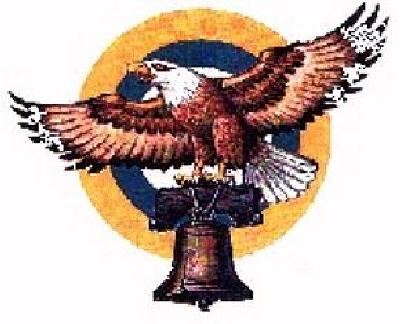 8th Bomb Squadron insignia 8th Bomb Squadron insignia
Approved June 21, 1954 (KE 8387)
B-57s to Vietnam: The following is from Historical Text Archive: Don Mabry: President Kennedy decided to stand behind Diem. He sent more military advisers
and Special Forces to the country. And the economic support increased
dramatically. By 1963, there were 16,700 advisers in South Vietnam. Although
these advisers were not supposed to engage in combat but some did. The US and
the South Vietnamese army adopted the strategic hamlet program, an effort to
beat the guerrillas by destroying villages which supposedly harbored them. In
addition, Diem attacked Buddhists who opposed his anti-Buddhist repression.
Some responded by immolating themselves to draw world attention. The US began
to think about withdrawing it support of Diem. There were indications that he
might negotiate a peace with North Vietnam. When South Vietnamese generals
began talking of overthrowing him, the US did not demur. He was overthrown and
murdered in November, 1963. It wasn't long before the new government was also
overthrown.
Lyndon Baines Johnson, who became President when Kennedy was murdered,
increased support for South Vietnam, for he saw US honor at stake. In early
1964, the Vietcong controlled almost half of the country. The US began a secret
bombing campaign in Laos in an effort to destroy Vietcong supply roots. On
August 2, 1964, the warship the U.S.S. Maddox was attacked. Then on August 4th,
the Maddox and another destroyer moved into North Vietnamese territorial waters
in the gulf of Tonkin, a violation of international law and an act of war. They
were fired on. Johnson, however, hid the truth and reported to Congress that
the incident constituted an attack on the United States. Congress by a vote of
466-0 in the House and 88-2 in the Senate passed the Gulf of Tonkin resolution
on August 7th, gaining the President of the United States the right to respond
to attacks as he saw fit. This was the legal basis for the Vietnam War. When
Congress repealed the resolution in 1970, the US continued to fight the war.
1968 Map of Vietnam & Chronological History (1964-1960) 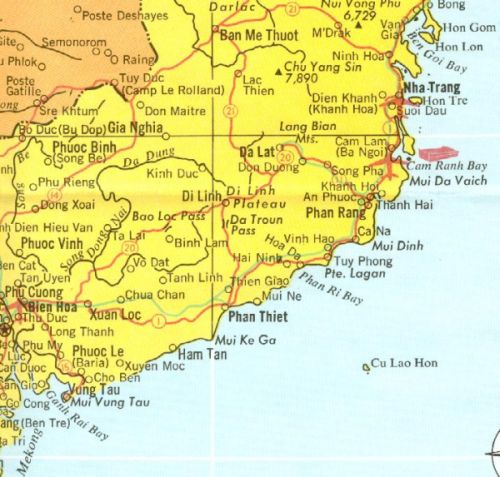
Bien Hoa and Phan Rang Location in Vietnam (1968 Map)
- 1964
- Aug. 2: U.S. destroyer Maddox reports attack by North Vietnamese patrol boats
in Gulf of Tonkin.
- Aug. 4: U.S. destroyer Turner Joy reports attack.
- Aug. 7: Congress passes Gulf of Tonkin resolution, giving Johnson broad
authority to conduct war.
- Nov. 1: Viet Cong attack Bien Hoa Air Base, destroying six B-57 bombers.
- 1965
- March 8-9: First American combat troops land in Vietnam.
- April 6: Johnson authorizes use of U.S. ground combat troops for offensive
operations.
- April 7: Johnson offers North Vietnam aid in exchange for peace.
- April 8: North Vietnam rejects offer.
- April 17: Students for a Democratic Society sponsor anti-war rally in
Washington.
- Oct. 15-16: Anti-war protests held in about 40 cities.
- Nov. 14-16: First major engagement between U.S. and North Vietnamese forces.
- Dec. 25: Johnson suspends bombing of North Vietnam to push for negotiations.
- 1966
- Jan. 19: Johnson asks Congress for $12.8 billion more for the war.
- Jan. 31: Bombing of North Vietnam resumes.
- May 1: U.S. forces shell communist targets in Cambodia.
- June 29: Johnson orders bombing of oil installations at Haiphong and Hanoi.
- Sept. 23: U.S. military says it uses defoliants to destroy communist cover.
- Oct. 26: Johnson visits troops in Vietnam.
- 1967
- Feb. 22: Operation Junction City, largest operation in Vietnam to date, begins.
- April 15: 100,000 war protesters rally in New York; 20,000 in San Francisco.
- May 19: U.S. planes bomb power plant in Hanoi.
- Sept. 3: Nguyen Van Thieu elected president of South Vietnam.
- Sept. 29: Johnson modifies position, saying the United States will stop bombing
if negotiations begin.
- Oct. 21: "March on the Pentagon" by tens of thousands of anti-war
demonstrators.
- October: U.S. public opinion on war shifts; polls say more Americans now oppose
Johnson's policies in Vietnam than support them.
- 1968
- Jan. 30: Viet Cong and North Vietnamese mount major offensives, catching South
Vietnamese Army offguard, celebrating Tet, the new year holiday.
- Jan. 31: Attack on U.S. embassy in Saigon repulsed. North Vietnamese capture
Hue.
- Feb. 10-17: U.S. casualties set a one-week record 543 killed in action.
- March 16: My Lai massacre of Vietnamese civilians by U.S. servicemen.
- March 31: Johnson announces de-escalation, says he will not run for
re-election.
- April 26: 200,000 demonstrate in New York City.
- May 12: Peace talks begin in Paris.
- Aug. 28: Anti-war protests and riots at Democratic National Convention in
Chicago.
- Oct. 31: Johnson halts bombing.
- 1969
- March: President Nixon announces "Vietnamization" plan to withdraw U.S. troops,
shore up South Vietnamese defenses.
- April 30: U.S. military personnel in Vietnam peak at 543,400.
- May 14: Nixon peace plan proposes mutual troop withdrawal.
- June 8: Nixon announces withdrawal of 25,000 troops.
- Oct. 15: National "moratorium" anti-war demonstrations attract huge crowds
across nation.
- Dec. 1: First draft lottery since 1942 is held.
B-57B History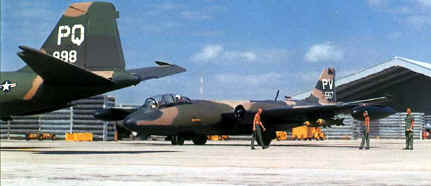
Aircraft 567 and 898 at Phan Rang (Bob Mikesh)
Note the "PQ" tail code of the 8th TBS and "PV" of the 13th TBS.
The following writeup of the B-57B is from Baugher site:
This would ordinarily have been the end of the service of the B-57B with the
USAF, with the 3rd BG being inactivated and all its planes being transferred to
the Air National Guard. However, the worsening situation in Indochina led to orders for the 8th and
13th Bomb Squadrons of the 3rd BG to deploy to Clark AFB in the Philippines for
possible action in Vietnam. As it happened, this move did not take place until August 5, following the
Gulf of Tonkin incident in which North Vietnamese gunboats clashed with US
destroyers.
According to the initial plan, 20 B-57Bs of the 8th and 13th BS were to be
deployed to the Bien Hoa air base near Saigon. This would mark the first
deployment of jet combat aircraft to Vietnam. This was technically a violation
of the Geneva Protocols which forbade the introduction of jet combat aircraft
to Vietnam, but the Gulf of Tonkin resolution which had just been passed by
Congress was taken as a pretext to remove all such restrictions.
The initial deployment to Vietnam got off on the wrong foot. The first two
B-57Bs to land collided with each other on the ground and blocked the runway at
Bien Hoa, forcing the rest of the flight to divert to Tan Son Nhut Airport on
the other side of Saigon. One of the B-57Bs dived into the ground during
approach at Tan Son Nhut and was destroyed, killing both crew members.
During the next few weeks, more B-57Bs were moved from Clark AFB to Bien Hoa to
make good these losses and to reinforce the original deployment. Things got so crowded at Bien Hoa at that time that some of the B-57s had to be
sent back to Clark AFB. Initially, the B-57Bs were not cleared for actual
combat missions, the aircraft being restricted to unarmed reconnaissance
missions that were mainly designed to boost the morale of the population.
However, actual combat was not to be delayed very long. On November 1, 1964,
Viet Cong squads shelled the airfield at Bien Hoa with mortars, destroying five
of the B-57s parked there and damaging 15 others. Further Viet Cong mortar
attacks led General William Westmoreland on February 19, 1965 to release B-57Bs
for combat operations. The first such mission took place on that same day, a strike against suspected
Viet Cong guerrillas near Bien Gia, about 30 miles east of Saigon. This strike
was, incidentally, the first time that live ordnance had been delivered against
an enemy from a USAF jet bomber.
The B-57Bs hit North Vietnamese territory for the first time on March 2, some
25 miles north of the DMZ. This was the first of a series of interdiction
strikes that came to be known as Rolling Thunder. The usual bomb load on these operations was nine 500-lb bombs carried in the
main weapons bay and four 750-lb bombs on the underwing pylons.
In April of 1965, B-57B crews began night interdiction strikes against enemy
supply lines along the Ho Chi Min Trail. Operations were carried out in cooperation with C-130 or C-123 flare-deploying
aircraft that illuminated potential targets and with USMC EF-10B Skyknight
electronics warfare aircraft that jammed radar-controlled AAA and detected
enemy missile sites that were preparing to launch. Eventually these night
interdiction missions extended into North Vietnam, the first such attack taking
place on April 21, 1965. However, it was considered too dangerous to fly C-130
flare-deploying aircraft into North Vietnamese airspace, so each B-57B carried
a set of MK-24 flares in addition to bombs.
On May 16, 1965, while waiting to takeoff on a mission, a B-57B exploded on the
ground at Bien Hoa, setting off a whole chain of secondary explosions. The
resulting conflagration destroyed ten B-57s, eleven VNAF A-1H Skyraiders, and a
US Navy F-8 Crusader. The surviving B-57s were transferred to Tan Son Nhut and
continued to fly sorties on a reduced scale until the losses could be made good. Some B-57Bs had to be transferred to Vietnam from the Air National Guard, and
12 B-57Es had to be withdrawn from target-towing duties and reconfigured as
bombers to make good these losses.
In June of 1965, the 3rd Bomb Group moved to Da Nang to carry out night
interdiction operations over North Vietnam and Laos. Principal targets were
trucks, storage and bivouac areas, bridges, buildings and AAA sites. When deployed at Da Nang, the 8th and 13th Squadrons came under operational
control of the 6252nd Tactical Fighter Wing which became the 35th TFW about a
year later.
Combat attrition in the B-57 force plus the increasing availability of higher
performance fighters to carry out the air war against the North caused the 3rd
BG to be withdrawn from operations against the North in October of 1966 and
relocated to Phan Rang, just south of Nha Trang and Cam Ranh Bay. However, it
appears that B-57 night missions over North Vietnam did continue until at least
Oct 1967. It carried out attacks against Communist forces in the Central
Highlands and supported US ground troops in the so-called "Iron Triangle".
While there, the B-57s operated alongside the Canberra B. Mk. 20s of No. 2
Squadron of the Royal Australian Air Force.
In January of 1968, the 13th Bomb Squadron was deactivated, and the 8th BS was
left in permanent residence at Phan Rang. The main emphasis was again on night
interdictions against the Ho Chi Minh Trail. By July of 1969, the 8th BS's
strength was down to only 9 aircraft, and it was decided that it was time to
retire the B-57B from active service. The surviving aircraft were sent back to
the USA in September and October and put into storage at Davis-Monthan AFB. The
identity of the 8th BS was transferred to another unit at Bien Hoa to become
the 8th Attack Squadron, which was equipped with Cessna A-37s.

Article "On Strike Mission with B-57...the Weapon Reds Fear Most" from "The Buffalo Evening News," Buffalo, NY. in 1965.
(Courtesy Norman Hartman) Out of the 94 B-57s that were assigned to the Southeast Asia theatre, 51 were
lost in combat (including 15 destroyed on the ground). 11 were withdrawn early
to support the B-57G program. 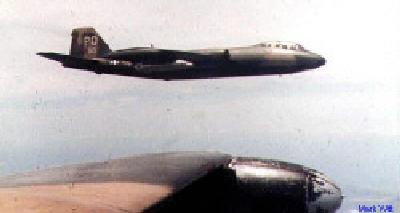 8th TBS Bomber configuration: photo- Mark Witt 8th TBS Bomber configuration: photo- Mark Witt
Note: PQ Tail Code of 8th TBS
(Courtesy Marquis Witt www.b-57canberra.org)Top L: Four napalm under the wing; Top R: Loading napalm
Bottom L: Maintenance Bottom R: Pilot view of bomb sight.
According to Canberra.org: B-57 in Vietnam, The Mission
During the Vietnam War, the B-57 was chosen as the first jet aircraft to strike
North Vietnam. Its long range and loiter capability with a large payload made
it the logical choice as the "Night Intruder" for interdiction on the Ho Chi
Minh Trail. The use of fire bombs, hard bombs up to 1000 pounds, 20 millimeter
and 50 caliber guns made the B-57 a formidable weapons delivery system against
the transfer of supplies through Laos and Cambodia into South Vietnam. With the
aid of C-130's, OV-10's and Ov-2 aircraft as Forward Air Controllers (FAC), the
B-57 was the most effective system used against transporting war goods into
South Vietnam through Laos and Cambodia.
The Eighth and Thirteenth Tactical Bomb Squadrons (8TBS, 13TBS) stationed at
Clark Air Base, Philippines initially launched sorties from Bien Hoa. Later,
Danang Air Base near the DMZ became the base of operations. The final station
was Phan Rang (Happy Valley) where the 8TBS, as the oldest continuously
operating bomb squadron in the Air Force (World War I), continued the mission
until 1969.
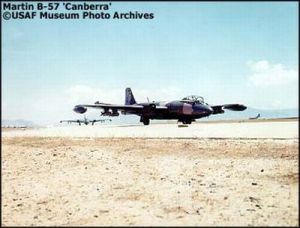 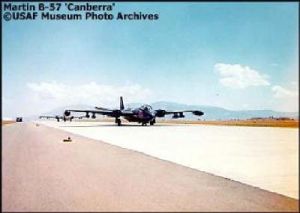
B-57 assigned to the 8th Bomb Squadron, 35th Tactical Fighter Wing (PQ) at Phan
Rang AB, South Vietnam in March 1969. (USAF Museum)The pilot was responsible for the 250 knot dive run and bomb release, but the
back seat navigator was a second pair of eyes, spotter, observer, navigator and
radio operator. On the pullout, the aircraft and crew were under a four "g"
stress without the use of special equipment. Several crews were lost in midair
collisions, target fixation and ground fire during the night missions. The most
sophisticated piece of equipment in the aircraft was the rheostat which lighted
the manually operated bomb sight. Interdiction Mission (1965) In the early 1960s, the A-26 (B-26 Invader), T-28, and B-57s were the planes
of choice for the interdiction campaigns. Later the F-4, F-105s and AC-130
Spectres became the weapons of choice. According to Thomas Pilsch: Interdiction, "A key part of the U.S. strategy in Southeast Asia was the interdiction of the
supply lines to the Viet Cong (VC) and North Vietnamese Army (NVA) units in
South Vietnam. These supply routes ran through neighboring Laos and Cambodia and have been
collectively referred to as the Ho Chi Minh Trail. In fact, there was no
official "trail." Rather, it consisted of a series of roads and footpaths of
varying condition depending on terrain, weather and level of U.S. interdiction
effort. Where possible, the North Vietnamese used trucks to transport supplies. These trucks became a primary target of the air war over North Vietnam and Laos
(Operations Rolling Thunder, Steel Tiger and Tiger Hound)."
"Some supplies were brought into the western areas of South Vietnam (especially
the A Shau Valley) by truck , but the last part of this supply chain in the
south was conducted by porters using trails cut through the jungle and over the
mountains under difficult conditions. FACs spent a significant amount of effort
looking for signs of movement in these border areas. The further down the Trail
supplies were moved and dispersed, the more difficult it became to locate and
destroy them. Throughout the war, South Vietnam and the United States also used
covert forces to monitor and interdict supply opeations along the Ho Chi Minh
Trail."
The following is from The Role of Airpower in Viet-Nam by Gen John P. McConnell, Chief of Staff, U.S. Air Force, in an address before
the Dallas Council on World Affairs, Dallas, Texas, 16 September 1965. The idea of nuclear umbrella seems antiquated now and the "wishful thinking"
in the speech is self-evident. But in 1965, this message to most people was
reasonable. Strategic Aerospacepower in Viet-Nam?
The question has been raised why we are not using this powerful strategic
capability to force an end to the war in Viet-Nam. There can be no doubt that we could destroy all of North Viet-Nam virtually
overnight. But while this might end the war in Viet-Nam, it could easily spark
a general nuclear war—the very contingency we are determined to avoid and deter. Moreover, such drastic action is neither necessary nor in accord with the declared
intentions and policies of this country.
Our policies in this respect were spelled out by President Johnson in his
historic address at Johns Hopkins University last April when he declared: "We
have no desire to devastate that which the people of North Viet-Nam have built
with toil and sacrifice. We will use our power with restraint and with all the
wisdom that we can command. But we will use it."
And use it we do, but only to the extent necessary to achieve our declared
aims. Toward this end, our strategic capability is utilized in two ways. First, our full nuclear strategic capability must continue to act as a deterrent, that is, provide us freedom of action in
taking whatever military measures are required in Viet-Nam without risking escalation
into nuclear war. Second, our conventional strategic capability is being applied, as the President said, with restraint and discrimination until the rulers of North Viet-Nam become
persuaded to agree to negotiations on an equitable basis. That point will be reached when these rulers recognize that the price of
continued aggression is higher than they are willing and prepared to pay.
It is evident, therefore, that the principle of "strategic persuasion" is not
meant to achieve total military victory, as all-out strategic airpower helped to achieve in World War II. Rather, it
is designed solely as an instrument of foreign policy for the attainment of a
diplomatic objective. The great advantage of such strategic persuasion lies in its flexibility. Under the protection of the nuclear umbrella, its pressure can be increased in measured steps, as may be necessary, while still being kept well below the
level uncontrollable escalation. By the same token, the pressure can be decreased if warranted by a reduction in the intensity of the enemy's aggressive
actions, as Secretary of Defense McNamara indicated in a TV interview a few
weeks ago. Finally, the pressure can be discontinued altogether at any time if it has achieved its purpose or if such action is expected to
foster its achievement.
There are indications that this measured application of the principle of
"strategic persuasion" in Viet-Nam is beginning to take effect. This is not surprising if it is realized that, in the past six months, South
Vietnamese and U.S. aircraft have flown over 15,000 sorties against carefully
selected targets in North Viet-Nam and dropped more than 14,000 tons of bombs
on them.
The targets included primarily lines of communication and military facilities
such as bridges, railroads, highways, barracks, ammunition depots, radar sites
and the like. Most of the targets in North Viet-Nam were attacked for the added
or principal purpose of helping to impede the flow of reinforcements and
supplies to the Viet Cong in South Viet-Nam. And this brings me to the second
new area of aerial operations in that war, namely, the use of airpower against
guerrillas.
Use of Aerospacepower Against Guerrillas
Offhand, it may seem futile to employ airpower in trying to combat extensive
guerrilla activities, especially under conditions as they exist in Viet-Nam.
There are no well defined fronts; virtually all of South Viet-Nam is the
battlefield and combat operations shift rapidly and unpredictably from one
locale to the other. Hiding in the jungle or mixing with the civilian
population, the Viet Cong normally strike in relatively small numbers and
whenever they have the advantage of surprise.
Moreover, the Viet-Cong continue to receive sizable reinforcements and an
incessant flow of materiel from the Hanoi regime. Deputy Secretary of Defense
Cyrus Vance stated in a talk a few months ago that the bulk of the Viet Cong
weapons—at least 60 to 70 percent, including almost all the heavy and modern
weapons—come from external communist sources. But therein lies also one weakness of the Viet Cong which airpower is well suited
to exploit, and that is through what is known as "interdiction" or attacks
against the lines, means and sources of supply.
As you will remember, our initial aerial interdiction effort was limited to
targets in South Viet-Nam in the hope that the conflict could be kept at the
lowest possible level of intensity. But in granting the North Vietnamese a
sanctuary where they could safely collect and store any amount of supplies for
the Viet Cong guerrillas, we found ourselves in the same position as a
narcotics squad that is trying to smash a dope ring by going after the pushers
but has no warrant to enter the ring headquarters from where the pushers are
directed and supplied.
When we began striking targets in North Viet-Nam last February, we not only
added greatly to the effectiveness of our efforts to impede the flow of
supplies to the guerrillas but we also made it increasingly costly for the
North Vietnamese to engage in the provision of these supplies. A bridge and a highway which carry a flow of military supplies to the
guerrillas in the South, normally serve local needs also, and when they are
destroyed as interdiction targets, all other traffic is disrupted at the same
time. This is the direct price which we are now exacting from the North
Vietnamese themselves for their active support of the guerrillas in South
Viet-Nam.
There can be no doubt that aerial interdiction, in combination with naval
surveillance of the sea supply routes, has greatly reduced the support which
the Viet Cong are receiving from the outside and that it will have an
increasing impact on their guerrilla operations throughout the remainder of the
war. But because of geographic conditions, these actions cannot cut off outside
support entirely; they can only reduce it and make it more costly. Nor is
reduction of outside support sufficient, by itself, to defeat the guerrillas
because they will continue to capture weapons and ammunition and to take
whatever else they need from the civilian populace.
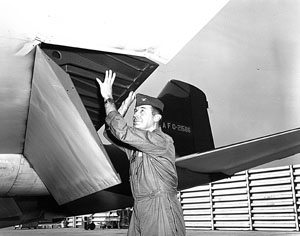 
Left: Col. Yeager preflighting his B-57 prior to taking off from Bien Hoa Air
Base, South Vietnam, September 1966.
Right: A B-57 from one of Yeager's squadrons flying over Phan Rang Air Base,
South Vietnam. | Col. Chuck Yeager "took command of the 405th Fighter Wing. With his
headquarters at Clark Air Base in the Philippines, Yeager commanded five
squadrons and detachments scattered across Southeast Asia: two tactical bomber
squadrons flying B-57s out of Clark and Phan Rang Air Base in South Vietnam ...
Yeager made an effort to visit and fly with each of these units once every
10-12 days. Flying primarily close air support and interdiction missions in a
B-57, he added 127 flights and 414 hours to his combat record." (Bud Anderson: Yeager Display) |
Canberra.org: Vietnam has a picture of a crew that was one of the first in Vietnam. However, if you
look at the hats closely, you'll see the second man from the right in the rear
row (Ken Blackwell) is wearing the 8th Bomb Squadron Liberty eagle hat. 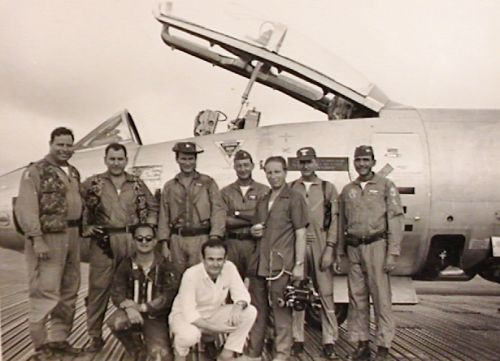 | (photo courtesy of Ken Blackwell) These men were among the very first to see
action in Vietnam in the Doom Pussy Squadron.
They have been identified as:
Back Row
"Smash" Chandler; (Bear?) "Nails" Nelson; Ed Cook; Jerry Russell; Ken
Blackwell; and Bill Breedlove.
The others are unidentified and believed to be photographers who wanted to "go
on a combat mission". |
8th TBS Assigned to 405th Fighter Wing (1964) In 1964, the 3rd Bombardment Wing was rotated to the States and the 3rd
Bombardment Group was deactivated in 1965 -- after 46 years of continuous
service. However, the 3rd Bombardment Wing changed designators to the 3rd
Tactical Fighter Wing and relocated to England AFB, Louisiana on 8 January
1965. See the 3rd Wing History.) Its three squadrons, the 8th, 13th and 90th Tactical Bomb Squadrons (TBS)
were split.
The 3rd Tactical Fighter Wing kept the 90th Bombardment Squadron, redesignated
as a Tactical Fighter Squadron (TFS) in 1965, and gained the 416th, 510th and
531st TFS. While at England AFB, the 3rd TFW was brought up to full strength
and equipped with the North American F-100 Super Sabre. (Later in 1968 when it
switched to the A-37B it would be reunited with its old sister squadron, the
8th, under the 3rd TFW.)
After this the 8th and 13th Tactical Bomb Squadrons were attached to the 41st
Air Division and later to the 2d Air Division as they mulled over the fate of
the squadrons.
The 8th and 13th TBS were realigned under the Thirteenth Air Force on 24 Apr 1964. At first, the squadrons were scheduled for deactivation --
and in fact, were the last active duty B-57s in the Air Force. However, the
increasing demands for aircraft in Vietnam caused the Air force to reconsider
the deactivation. The aircraft to be moved to Clark AB, Philippines. First
the units went to the 33rd Tac Group (18-28 Jun 65); then to the 2d Air
Division (28 Jun-7 Jul 65); then finally to the 6252nd Tactical Fighter Wing (8
Jul-7 Apr 66) with rotations back to Clark. The Gulf of Tonkin incident was
the impetus to move the Canberras of the 8th and 13th on a rotational basis to
Bien Hoa -- to take on the role of Night Intruder on the Ho Chi Minh Trail.
Then both the squadrons were placed under to the 405th Fighter Wing (24 Apr 1964 - Apr 1966) but attached to a number of units over the next four
years. In 1966, the 35th TFW moved to Phan Rang and took over the units until
Jul 68 when the decision was made to deactivate the B-57s. Though the
historical accounts state that the 3rd BG was removed from missions over the
North after their move to Phan Rang in 1966, it appears that the night missions
continued until at least Oct 1967. In 2004, John Hurley wrote, "In the history of the 8th, I found a small discrepancy concerning the
8th's move to Phan Rang AB. It stated that after the 8th moved to Phan Rang, it
did not continue operations in North Vietnam. Actually the 8th did continue
night missions in the North until after October 1967. I do not know when they
were discontinued. I was a pilot in the 8th for two different periods:
1959-1963 and 1966-1967. I'm in the 1000hrs accident free flying picture. No
hat left side."
The 405th's initial deployment to Vietnam was a catastrophe hit. The first two
B-57Bs to land collided with each other on the ground and blocked the runway at
Bien Hoa forcing the rest of the flight to divert to Tan Son Nhut Airport. One
of the B-57Bs dived into the ground during approach at Tan Son Nhut and was
destroyed, killing both crew members. But its woes didn't end there. Mark
Witt stated, in Cat of Doom Story, "November 1, 1964: Two days before the U.S. presidential election, Vietcong
mortars shell Bien Hoa Air Base near Saigon. Four Americans are killed, 76
wounded. Five B-57 bombers are destroyed from the ensuing explosions. Fifteen
were damaged. Whether or not the mortars caused the explosions or faulty bomb
fuses, as some have suggested. the result was devastating to the B-57 force.
It led to the relocation of the force to other bases and finally the
installation of revetments at Phan Rang." (SITE NOTE: People: Chronology states, "October 30: In a Vietcong attack on the US airbase at Bien Hoa, six B-57 bombers are destroyed and five Americans are killed.")
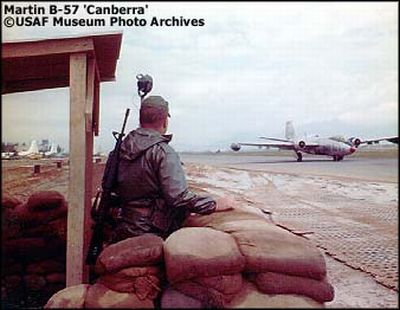
B-57 (probably a -B model) at Da Nang AB,
South Vietnam taken in December 1965. (USAF Museum)
This incident also convinced General Westmoreland to allow the B-57s to enter
combat on February 19, 1965 -- despite qualms that it would violate the Geneva
Convention. This incident is still used as the model of how a small,
well-trained force can inflict serious damage with a hit-and-run mortar attack.
The Viet Cong, in less than five minutes, wiped out an entire squadron of
aircraft.
In February, 1965, a Vietcong attack on the US military airfield at Pleiku
brought a carrier attack on North Vietnam. The US launched Operation Rolling
Thunder , bombing north of the 17th parallel in an effort to get them to quit
aiding the Vietcong and/or fighting in South Vietnam. The first U.S. Air Force
jet raids were flown against enemy concentrations in South Vietnam. B-57
Canberras and F-100 Super Sabres flew against the Viet Cong near An Khe. The US
would drop more bombs on Indochina than it has dropped in World War II. Johnson
increased the US ground troops. The Army of the Republic of Vietnam (ARVN)
suffered great losses through desertions. By the end of 1965, there were
184,000 US troops there; then 385,000 at the end of 1966; and, finally, the
peak number of 543,400 in 1969.
The following is from Historical Text Archive: Don Mabry: By early 1966, Senator J. William Fulbright (Democrat from Arkansas) began to
hold hearings on the war. As they progressed and Fulbright found more of the
truth of the matter, he became a vocal critic of the war and delivered a major
address about "The Arrogance of Power.". Johnson realized that the US needed to
negotiate an end and, by 1968, negotiations had begun with Averill Harriman
leading the US effort. Johnson announced in early, 1968 that he would not seek
re-election so that he would not be an obstacle to the peace talks.
In November, 1968, North Vietnam had responded to the start of negotiations in
Paris by withdrawing 22 of 25 regiments from the northern 2 provinces of South
Vietnam. President Johnson kept up the bombing pressure, and the withdrawals
ceased. Thieu of South Vietnam stalled at sending delegates; he was afraid the
South would lose. When his delegates finally arrived, they stalled for five
more weeks by arguing over the shape of the table.
Richard Nixon, Republican, who narrowly beat Johnson's vice-president Hubert
Humphrey, and US policy changed. In Guam in July 1969, the US said that it
would not try to solve all the problems of all world. This presumed retreat
from overseas activity reflected the national mood for US citizens were tired
of the Vietnam War and feared that the country was trying to do too much. By
1971, however, Nixon was warning of the danger" of "under involvement" and
emphasized that the Nixon Doctrine did not mean the precipitate shrinking of
the US role in the world. The Nixon doctrine seemed to apply primarily to Asia.
Nixon had campaigned that he had a "secret plan" to end the war. Wits said that
he should reveal the secret immediately so as to save lives but, of course, he
waited until he took office in 1969. It turned out that he was going to reduce
US casualties by having the South Vietnamese assume the responsibility of
fighting their own civil war. Nixon proposed to "wind down" the war through
this Vietnamization. US ground troops declined from a high of 543,400 (April
1969) to a low of 60,000 (September, 1972). This move resulted in lower US
casualties and fewer draftees in Vietnam; thus sharply diminishing the domestic
political impact. According to Smithsonian NSAM: While the B-57 possessed superb performance at the time of its introduction, it
had several traits that made the aircraft difficult, and at times dangerous, to
fly. Unlike other early jets, it did not need ground-starting equipment because
a starter cartridge charge, utilizing a powerful propellant, turned a small
turbine that, in turn, brought the compressor rpm of the engines up to a
sufficient level to sustain ignition. This feature, intended to aid in
dispersal to forward airfields produced a heavy, toxic smoke and was
cumbersome. The B-57 did not have control boost to assist the pilot during
maneuvering, which was unusual for an aircraft of its size and speed range.
Combined with limited rudder authority, this omission made loss of control
likely, should one engine fail during a critical phase of flight.
B-57Bs flew more than 31,000 operational sorties in Vietnam and Laos between
February 1965 and October 1969. RB-57s also participated in thousands of
reconnaissance missions during the conflict. The B-57 was not the only Canberra
in Vietnam - the Royal Australian Air Force (RAAF) also operated the type.
Although it was hardly the most numerous USAF combat aircraft in Vietnam, the
Canberra nevertheless proved itself on missions that were usually much
different from the high-altitude level bombing missions originally envisioned
for the aircraft. As the Vietnam War widened in scope, from lower-intensity
counter-insurgency operations to aggressive air campaigns against an enemy with
the latest Soviet weaponry, the USAF committed larger numbers of front-line
aircraft, previously reserved for their deterrence value against the communist
bloc. Supersonic strike aircraft such as the F-4 and F-105, better suited to
low-altitude weapons delivery, replaced the increasingly obsolescent Canberras,
as did B-52s, which could carry a bomb load more than eight times that of the
2,722 kg (6,000 lb) carried by the B-57. Assistance to RVNAF B-57 Program (1964-1965) "Vietnamization" was the latest catchword in 1964 and its intent was to
turning over more of the fighting to the Vietnamese. According to Joe Baugher: RVNAF B-57, "In 1964, the United States secretly agreed to supply a few B-57Bs to the
Vietnamese Air Force. The United States had initially been reluctant to equip
the Vietnamese Air Force with jet aircraft, since this would be a technical
violation of the Geneva Accords and might further escalate the war. However,
the US bowed to pressure from Saigon. The first VNAF B-57 crews began training
in secret at Clark AFB in the Philippines later in 1964. Later training took
place at Tan Son Nhut instead of Clark. One of the students was none other than
Nguyen Cao Ky, the commander of the VNAF and later president of the Republic of
Vietnam. On August 1, 1965, the blanket of secrecy was removed and an
announcement was made that four B-57 bombers would be provided to the Vietnam
Air Force. Four B-57Bs, painted in VNAF insignia, flew past during a formal
presentation ceremony held on August 9."
The new program began on September 20. Each pilot was to receive 70 hours in
the airplane with no less than 40 training sorties. Navigator training began on
October 11. As the crews completed their training, they went to Da Nang and
flew combat missions with the USAF 8th or 13th Bomb Squadrons, whichever
happened to be on station at the time.
On October 29, 1965, five B-57s from the 8th Bomb Squadron, then based at Da
Nang, were repainted with VNAF insignia and carried out an air strike against a
suspected VC stronghold and landed Tan Son Nhut. After landing, the planes took
off again and joined other VNAF aircraft in a formation flyover of Saigon.
Although manned solely by American crews, this attack was heralded as the
introduction of VNAF B-57s into combat.
However, the RVNAF B-57 training program began to run into serious morale
problems. Malingering brought the training to a standstill. Some Vietnamese
crews flatly stated that they could not physically perform the maneuvers
required in the B-57. From this point on there was very little Vietnamese
activity in the B-57 program. On April 20, 1967, the VNAF B-57 operation was
formally terminated.
8th TBS Rotation (1965-1968) The 8th TBS continued to bounce between Clark AB, PI and Vietnam on a monthly
rotational basis under 405th TFW between 1965-1967. In Oct 67, the 8th and 13th were permanently based out of
Phan Rang.
A small tidbit appeared in the "The Phan Rang Weekly" on August 2, 1967. The
bit tells of two pilots of the 8th SOS reaching the 200 mission mark. But the
interesting point is that they were on "two-month rotational combat tours"
meaning that they rotated in from Clark.Last week's temperature showed an extreme maximum of 102 degree and an extreme
minimum of 76 degrees. Precipitation over a five day period was just .13 of an
inch.
****************************************************
THEIR 200TH MISSION
Capt.Charles R. Rasnic, 8th TBS pilot, flew his 200th combat mission in Vietnam
Sunday.
Lt.Col. Nathaniel Gallagher, the 8th TBS Operations Officer, turned the same
trick on Monday.
Both are completing their third two-month rotational combat tour in Vietnam,
averaging a combat mission per day. The 13th TBS remained assigned to Clark between till the 13th TBS was
deactivated in Jan 68. The 13th TBS aircraft were withdrawn to form the B-57G
unit for the re-born 13th TBS. The last of the monthly rotations was in 15 Jan
68.
Because of losses sustained in Vietnam, twelve B-57Es used for target towing
were returned to Martin in 1965 for modification to the bomber role. The target
towing equipment and control system was removed and the standard bomb system
from the B-57B was installed. Once conversion was complete, most aircraft were
assigned (initially) to the 8th Tactical Bombardment Squadron, 405th Tactical
Fighter Wing at Clark Air Base, Philippines.
The deployments to Vietnam started off as three-month rotations, but soon
became a two-month deployment schedule becomes readily apparent when you
combine the assignments of the 8th and the 13th together. (Source: AFHRA: 80th SOSand AFHRA: 13th BS.) - 13TBS -- Bien Hoa AB, South Vietnam, 5 Aug-3 Nov 1964
- 13TBS -- Bien Hoa AB, South Vietnam, 17 Feb-16 May 1965
- 13TBS -- Tan Son Nhut AB, South Vietnam, 16 May-21 Jun 1965
- 8TBS -- Tan Son Nhut AB, South Vietnam, 18-28 Jun 1965
- 8TBS -- Da Nang AB, South Vietnam, 28 Jun-15 Aug 1965
- 13TBS -- Da Nang AB, South Vietnam, 16 Aug- 16 Oct 1965
- 8TBS -- Da Nang AB, South Vietnam, 16 Oct-16 Dec 1965
- 13TBS -- Da Nang AB, South Vietnam, 16 Dec 1965-17 Feb 1966
- 8TBS -- Da Nang AB, South Vietnam, 15 Feb-18 Apr 1966
- 13TBS -- Da Nang AB, South Vietnam, 17 Apr- 17 Jun 1966
- 13TBS -- Bien Hoa AB, South Vietnam, 15-22 May 1966
- 8TBS -- Da Nang AB, South Vietnam, 15 Jun-15 Aug 1966.
- 13TBS -- Da Nang AB, South Vietnam, 14 Aug-9 Oct 1966
- 13TBS -- Phan Rang AB, South Vietnam, 10- 13 Oct 1966
- 8TBS -- Phan Rang AB, South Vietnam, 12 Oct–12 Dec 1966
(12 Dec 1966 -11 Feb 1967 Missing in AFHRA Record: Assume 13th TBS monthly rotation)
- 8TBS -- Phan Rang AB, South Vietnam, 11 Feb–12 Apr 1967
- 13TBS -- Phan Rang AB, South Vietnam, 12 Dec 1966-11 Feb 1967
(11 Feb - 11 Apr 1967 Missing in AFHRA Record: Assume 8th TBS monthly rotation)
- 13TBS -- Phan Rang AB, South Vietnam, 11 Apr-8 Jun 1967
- 8TBS -- Phan Rang AB, South Vietnam, 7 Jun–2 Aug 1967
- 13TBS -- Phan Rang AB, South Vietnam, 1 Aug- 26 Sep 1967
- 8TBS -- Phan Rang AB, South Vietnam, 26 Sep–22 Nov 1967
- 13TBS -- Phan Rang AB, South Vietnam, 21 Nov 1967-15 Jan 1968. (NOTE: 13th TBS
deactivated 15 Jan
1968. 8th TBS assigned to 35th TFW 17 Jan 68.)
- 8TBS -- Phan Rang AB, South Vietnam, 17 Jan 1968 (NOTE: Combat losses. 8th TBS
down to 8 a/c decision to retire the B-57B in July 1969. )
Casualties (1964-1968): Flying the B-57 was a risky business. Out of the 94 B-57s that were assigned
to the Southeast Asia theatre, 51 were lost in combat (including 15 destroyed
on the ground). By Jul 69 only 8 aircraft were left in the 8th TBS.
Immediately upon deployment of the B-57s to Vietnam did tragedy strike. The
initial deployment (5 Aug-3 Nov 1964) to Vietnam got off on the wrong foot.
Twenty (20) B-57Bs of the 8th and 13th Tactical Bomb Squadrons were deployed to
the Bien Hoa air base near Saigon, marking the first deployment of jet combat
aircraft to Vietnam. The first two B-57Bs to land collided with each other on
the ground and blocked the runway at Bien Hoa, forcing the rest of the flight
to divert to Tan Son Nhut Airport on the other side of Saigon. Joe Baugher site: B-57B, One of the B-57Bs dived into the ground during approach at Tan Son Nhut and
was destroyed, killing both crew members from the 13th TBS, 405th TFW. This
supposedly was the FIRST pilot death in Vietnam.
However, Clarion Ledger differs on the cause of deaths of Capt. Fred "Potlick" Clay Cutrer (pilot) and
1Lt. Leonard L. Kaster (nav). According to the article they were lost to
gunfire in Long Khan Province on Aug. 5, 1964. The remains of Capt. Fred
"Potlick" Clay Cutrer lay buried one meter beneath the surface of a jungle bog
for 33 years, mired in obscurity and hidden from his family's grasp for
closure. In the spring of 1997, the Department of Defense, with the aid of a
Vietnamese native who saw Cutrer's B-57 Bomber plummet to earth in Dong Nai
Province Aug. 5, 1964, made a discovery and started the Cutrer family's healing.
The Virtual Wall stated: "On 6 August 1964, Captain Fred C. Cutrer, pilot, and 1LT Leonard L. Kaster ,
navigator, were returning from a mission in B-57B tail number 53-3870 when
their aircraft crashed into the Song Dong Nai River in Long Khan Province, SVN,
about 25 miles northeast of Bien Hoa. It was and remains unclear whether they
were bought down by enemy fire or if it was an operational loss. In any case,
the remains of the two men could not be recovered. When Captain Cutrer's
memorial was was first published on 06 Oct 2001, neither Cutrer's nor Kaster's
remains had been identified. However, the crash site actually had been located
and excavated in 1997. On 25 October 2001, the government announced
confirmation that Captain Cutrer and 1LT Kaster both died in the crash. Reports
indicate that both ejection seats (and hence both crewmen) were in the aircraft
when it crashed.
In an e-mail dated Wednesday, 22 May 2002, Captain Cutrer's son advised that
while his father's dogtag had been recovered from the wreckage the very small
sizes of the human bone fragments recovered precluded positive identification
of either man.
The recovered remains were buried together in Arlington National Cemetery on 06
June 2002. The privately operated Arlington Cemetery site has a report on the
burial . Press reports reproduced on that site indicate that 1st Lt Kaster (and
presumably Captain Cutrer) was awarded a posthumous Purple Heart at the burial
ceremony. During the next few weeks, more B-57Bs were moved from Clark AFB to Bien Hoa to
make good these losses. Initially, the B-57Bs were restricted to unarmed
reconnaissance missions, but actual combat was not delayed very long.
On November 1, 1964, Viet Cong squads shelled the airfield at Bien Hoa with
mortars, destroying five of the B-57s parked there and damaging 15 others. On
19 Feb 1965, the B-57Bs were released for armed combat operations with the
first mission taking place the same day. The B-57Bs hit North Vietnamese
territory for the first time on March 2, some 25 miles north of the DMZ.
On the second deployment (17 Feb-16 May 1965) to Bien Hoa AB, South Vietnam,
the 13th TBS, 405th TFW lost another crew. According to Scope Sys: POW Bio;Virtual Wall and Far away-So Close: On April 7, 1965, Capt. Arthur D. Baker (nav) and Captain James W. Lewis
(pilot) launched in a B-57B, one in a flight of four aircraft on an
interdiction mission from Bien Hoa Air Base, South Vietnam and targeted in
Xieng Khouang Province, Laos. Their aircraft was last seen descending through
thin overcast toward the target area and it never reappeared. Extensive search
and rescue efforts through April 12th failed to locate either the aircraft or
its crew. On April 14, 1965, the New China News Agency reported the shoot down
of a B-57 approximately three miles north-northeast of the town of Khang Khay.
This was described as the first B-57 shoot down of an aircraft launched from
South Vietnam.
Both crewmen were initially reported missing in action in South Vietnam while
on a classified mission. Their loss location was later changed to Laos. In
January 1974 Major Baker's next-of-kin requested his case review go forward and
he was declared killed in action, body not recovered, in January 1974. Lewis
was declared dead/body not recovered, in April 1982. At the end of the second deployment to Bien Hoa, another tragedy hit. On May
16, 1965, while waiting to take off on a mission, a B-57B exploded on the
ground at Bien Hoa, setting off a whole chain of secondary explosions. The
resulting conflagration destroyed ten B-57s, eleven VNAF A-1H Skyraiders, and a
US Navy F-8 Crusader and caused numerous casualties among air and ground
crewmen.
Grace K. Baldonado wrote on Virtual Wall, "My husband Secundino (Dean) Baldonado was killed in Bien Hoa Air Base,
Republic of Viet Nam. He was killed as a result of a series of explosions of
B-57's. The B-57's were preparing for combat missions. Some of them had already
taken off and others were preparing to be launched when one of them blew up
which caused a chain reaction. It was my understanding that my husband had been
pulling men out and the last time he went in to get someone he was caught in an
explosion." 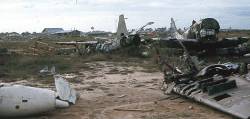
Damage after Explosion at Bien Hoa (16 May 1965)On the fifth deployment (28 Jun-15 Aug 1965) to Da Nang AB, South Vietnam an
8th TBS crew was lost. According to Virtual Wall, On the night of 21/22 June 1965, Captains Charles K. Lovelace , pilot, and
William E. Cordero, navigator, launched from Tan Son Nhut Air Base in B-57B
tail number 53-3910 for a night flare mission (i.e., a pathfinder mission for
other strike aircraft) over North Vietnam's southernmost province in the
vicinity of the Lao/NVN border. The B-57B went down and both crewmen were lost.
Later in the war their remains were recovered and laid to rest in Section 46 of
Arlington National Cemetery, adjacent to the Memorial Amphitheater.
On the tenth deployment (17 Apr- 17 Jun 1966) to Da Nang AB, South Vietnam, a
13th TBS crew was lost. Task Force Omega noted: The B57 Canberra was a light tactical bomber that first arrived in Southeast
Asia in 1964. As a veteran of operations Rolling Thunder in North Vietnam and
Steel Tiger in Laos, it played an important roll in interdicting communist
supplies moving along the Ho Chi Minh Trail. Some of the B57's from the 13th
Bomb Squadron located at DaNang and the 8th Tactical Bomb Squadron at Phan
Rang, South Vietnam had also been equipped with infrared sensors for night
strike operations in Tropic Moon II and III in the spring of 1967.
The Mu Gia Pass was one of two major ports of entry into Laos used by the
communists. When North Vietnam began to increase its military strength in South
Vietnam, NVA and Viet Cong troops again intruded on neutral Laos for sanctuary,
as the Viet Minh had done during the war with the French some years before.
This border road was used by the Communists to transport weapons, supplies and
troops from North Vietnam into South Vietnam, and was frequently no more than a
path cut through the jungle covered mountains. US forces used all assets
available to them to stop this flow of men and supplies from moving south into
the war zone.
On 13 June 1966 Lt. Col. Charles W. Burkart, Jr., pilot; and then 1st Lt.
Everett O. Kerr, navigator; comprised the crew of a B-57 Canberra in a flight
of 3 aircraft conducting a night strike mission against Route 911, the primary
road running through the Mu Gia Pass and south in Khammouan Province, Laos. The
mission identifier for this flight was Steel Tiger.
The three strike aircraft departed DaNang approximately 0100 hours. Prior to
reaching the target area, the flight was forced to separate due to bad weather.
Once Lt. Col. Burkhart's B-57 arrived in the target area, it rendezvoused with
the rest of the flight, the Airborne Battlefield Command and Control Center
(ABCCC) responsible for controlling all air operations in this region and the
Forward Air Controller (FAC) responsible for directing their strike mission.
After checking in with the ABCCC, the strike aircraft were handed over to the
FAC who directed them to proceed with their briefed mission.
At 0154 hours, the last known radio contact was established with Lt. Col.
Burkart and 1st Lt. Kerr. The Canberra's crew transmitted that they were
roughly 8 miles southeast of the city of Ban Som Peng at that time. Further,
they did not indicate they were experiencing any difficulty with the aircraft
or the mission.
During the course of the operation, other aircrews tried to establish radio
contact with Lt. Col. Burkart and 1st Lt. Kerr, but were unsuccessful in doing
so. When the ABCCC was also unable to establish radio contact, the pilot
requested an aerial search and rescue (SAR) operation be initiated. In the poor
visibility and darkness, the other aircrews saw no parachutes. They also heard
no emergency radio beepers emanating from the jungle below.
At first light the SAR aircraft searched the sector in and around the area of
last contact. When no trace of the missing aircraft or its crew was found along
Route 911 or in the surrounding jungle covered mountains, the SAR effort was
suspended. Because of the intense enemy presence throughout the entire region,
no ground search was possible. At the time the formal search was terminated,
both Charles Burkart and Everett Kerr were listed Missing In Action.
At the time of last contact, the Canberra was operating just to the west of
Route 911 as it ran through a densely forested long and very narrow valley with
steep, rugged mountains rising up on both sides. The Xe Rangfai River weaved
its way through the rugged mountains less than ¼ mile east of Route 911 at the
location of loss. The entire sector was heavily defended and densely populated
with communist forces.
The location was approximately 3 miles west of a Binh Tram, a way station used
by communist forces as they moved along the Ho Chi Minh Trail; 8 miles
northwest of Ban Thapachon, 13 miles south-southeast of Ban Senphon; 20 miles
southwest of the Lao/North Vietnamese border and 24 miles south of the Mu Gia
Pass. It was also 58 miles west-southwest of the major North Vietnamese port
city of Dong Hoi.) On the 8th deployment (16 Dec 1965-17 Feb 1966), to Danang, South Vietnam, the
13th TBS, 405th TFW lost a crew. According to Virtual WallBy early 1996 the 8th and 13th Bomb Squadrons from the 405th Fighter Wing at
Clark Air Base, Philippines, were solidly entrenched in South Vietnam. The 13th
Bomb Squadron was attached to the 6252nd Tactical Fighter Wing at Danang and
was spending much of its time on night missions over the Ho Chi Minh Trail in
Laos.
On 10 Feb 1966, Captains Russell P. Hunter, pilot, and Ernest P. Kiefel,
bombardier-navigator, departed Danang in B-57B tail number 52-1575 for a visual
bombing mission, working with a C-130 flareship. The two aircraft were
prosecuting a target near Ban Vangthon when, after his second bombing pass,
Hunter reported an unspecified problem with his aircraft and that he and Kiefel
were leaving the aircraft. The C-130 observed the B-57's impact with the ground
and SAR forces later located the wreckage, but no trace was found of either
crewman. The two men were classed as Missing in Action.
Eventually the Secretary of the Air Force approved Presumptive Findings of
Death for Lieutenant Colonel Hunter (20 June 1974) and Colonel Ernest Kiefel
(15 Jan 1979). Their remains have not been repatriated. On the 13th deployment (14 Aug-9 Oct 1966) to Da Nang AB, South Vietnam, the
13th TBS, 405th TFW lost another crew. According to USAFA Class History: 1959September 19, 1966: Cpt William S. Davis, III was killed in combat while flying
a B-57 in South Vietnam. We have no other details at this time. No Quarter states that he was from Demarest, New Jersey and born on Nov 17, 1936.
Casualty Date was Sep 19, 1966. It was due to hostile action inQuang Ngai
Province. Body recovered. After the deployments ended on 25 March 1968 at Phan Rang, the 8th TBS, 35th
TFW lost a crew member. According to Virtual WallAccording to John E. Retz, Captain, USAF (Ret), "B-57 aircraft crashed on
landing due to battle damage (had one engine out with a loss of hydraulic
pressure) attempted a missed approach which was not successful.
"I was stationed with Dick Hopper (Capt Richard Whan Hopper) at Plattsburgh
AFB, NY, flying B-47's and also provided assistance in his check out in the
B-57 at Hill AFB, Utah, in the summer of 1967." After the deployments ended on 13 Dec 1968 at Phan Rang, the 8th TBS, 35th TFW
lost a crew. (See Mid-air Collision for another account of this incident.) According to Virtual WallOn 13 December 1968 a C-123K On 13 December 1968 a C-123K PROVIDER of the 606th Special Operations Squadron launched from Nakhon Phanom RTAFB,
Thailand, on a night FAC mission over the Ho Chi Minh Trail area. The
low-and-slow C-123K's mission was to obtain visual or infrared sightings of
traffic along the Trail and to act as a controller for bombers - in this case,
B-57 CANBERRA bombers from the 8th Tactical Bomber Squadron, Phan Rang AB, SVN.
Weather conditions along the Trail were good - clear with a half moon, ground
fog, no wind and no cloud ceiling. At 0300 hours, as a B-57 was executing an
attack against ground targets, the B-57 collided with the upper surface of the
circling C-123K. Both aircraft - and nine aircrewmen - went down.
- Only one - 1st Lt Thomas M. Turner from the C-123 - was rescued. The others
simply disappeared into the Laotian jungles about 30 miles southwest of the Ban
Kari Pass. A ground search was impossible due to total enemy control of the
area, but airborne search-and-rescue operations continued until the formal SAR
effort was terminated on 15 December. At that point, the crewmen and their
status were as follow:
- 606th SOS, C-123K call sign CANDLESTICK 44
- 1st Lt Thomas M. Turner, pilot, rescued;
- 1st Lt Joseph P. Fanning, co-pilot, MIA;
- 1st Lt John S. Albright, II, navigator, MIA;
- 1st Lt Morgan J. Donahue, navigator, MIA;
- Then-SSgt Douglas V. Dailey, flight engineer, MIA;
- TSgt Fred L. Clarke, loadmaster, MIA; and
- SSgt Samuel F. Walker, Jr., loadmaster, MIA.
- 8th Tactical Bomber Squadron, B-57B call sign YELLOWBIRD 72
- Major Thomas W Dugan, pilot, MIA, and
- Major Francis J McGouldrick, bombardier, MIA.
None of the men returned with other POWs in February 1973, nor did any of the
released POWs have knowledge of the CANDLESTICK or YELLOWBIRD crewmen. As time
passed, the Secretary of the Air Force approved Presumptive Findings of Death
for the eight missing crewmen - including Major Thomas W. Dugan (20 July 1978).
The 8th TBS, 35th TFW of Phan Rang lost a crew on a date unspecified. The
status was changed to KIA status on June 28, 1978. According to Virtual WallLt Col Norman Dale Eaton, pilot, and Capt Paul E. Getchell, bombardier, flying
a B-57B (tail number 52-1561), were lost on a night interdiction mission about
10 miles south of the western end of the A Shau Valley in Savannakhet Province,
Laos. Although the aircraft was seen going down in flames, there were no signs
that the crew ejected and no contact was made with them on the ground.
The Secretary of the Air Force approved a Presumptive Finding of Death for Lt
Col Paul Getchell on 21 March 1979. As of 09 Nov 2002 the remains of the two
men have not been repatriated. The Guns of Tchepone (Mar 66)The following is from Canberra.org::The Guns of Tchepone
A story of heroism-
and skill As told by: Larry Mason, and Jere Joyner
Bob Mikesh, and Joe Rup, Jr.
On 15 March 1966, near the infamous Tchepone, Laos] (Map of the area)
"… Capt Larry Mason [of the 8th TBS] was on a strafing run on enemy trucks when
his Canberra was hit by anti-aircraft fire. The damage was so severe that the
aircraft rolled almost inverted but held together. After regaining control of
his aircraft, Larry's first thought was that he and his navigator Capt Jere
Joyner, would have to eject. His cockpit indications showed loss of power on
one engine and a fire warning light on the other. Struggling as he reached
forward, Jere passed him a blood-stained message which read, 'Hit badly arm and
leg losing blood."'
Realizing that Jere possibly would not survive bailing out, Larry passed him a
tourniquet and gingerly headed his crippled and radio-less B-57 to DaNang. He
was successful in reaching the base, but the landing gear indicators showed the
left main and nose gear in the intermediate position and the right main gear
down. Unknown to Larry was that one of the shell hits caused all three gear to
drop down and lock, while the cockpit indication was erroneous. Pressed with
getting his navigator to medical aid, yet unable to get a safe gear down
indication, Larry placed the gear handle in the up position on this third pass
at the field and made what he thought would be a gear-up landing. To his
amazement, the aircraft landed smoothly on the extended gear and made a normal
rollout. For this heroic outcome that saved the life of his navigator, Capt
Mason received the Thirteenth Air Force "Well Done" Award, the USAF "Well Done"
Award, the Koren Kolligian Jr. Trophy for 1966, the Order of the Able Aeronaut,
and more important - the Air Force Cross, the only AFC connected with B-57
operations.
A postscript to this harrowing story is that the Canberra, tail number 906 also
survived this encounter, thanks to the crew, and the ground maintenance
personnel that healed its wounds. After nearly three more years of combat, it
was modified as a B-7G and was again returned to combat.
From Robert Mikesh's description in Martin B-57 Canberra, the Complete Record, Robert C. Mikesh, Schiffer Military/Aviation History, 1995
From Colonel Joe Rup, Jr.
"When Larry got back he was make the first and only (that I know of)
single-engine go-around since he had no wing to speak of on the good engine
side and a full wing but no power on the other. Quite a feat!"
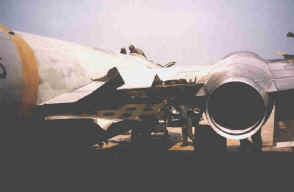 
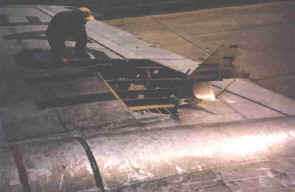 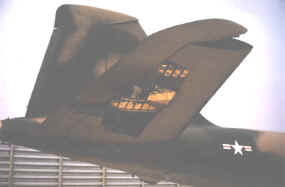 | Top L: Right wing of B-57B 53-5906 from the cockpit.; Top R: Right side from
rear of aircraft; Bottom L: From left rear of rear cockpit.
The navigator's instrument panel
is at left upper portion of the
photo. The reddish stain is blood.; Bottom R: Captain Art Kono in Yellowbird 21
made a pass on the same area and seeing another aircraft that had been
destroyed mistakenly reported on his return that Mason and Joyner had been shot
down. The photo shows his reward for the intrusion against the guns. (Photos
Joe Rup, Jr.) |
Pilot Larry Mason adds this:
"From my letter to my wife, Nancy, dated 19 March 1966:
"'Target intelligence has confirmed that there were 16 mm, 37 mm and 57 mm
anti-aircraft gun batteries and six 12.7 mm anti-aircraft gun batteries in the
flack trap that got us. The truck on the road was used as bait to lure us into
that trap. They had us point blank, but we got away. That same day, after we
got hit, there was an all-out effort to knock out those guns. But, it cost.
They shot down one Army Mohawk, one A1E and damaged another, plus my FAC (and
Art Kono's damage). It cost four lives. But, with God's help, I'm still here .
. . '"
And from Jere's letter, written 19 May 1966 to Larry Mason:
"Yes, I did see the ground fire. Just as we made our turn I saw the target
clearly and we had well over 300 KIAS (knots indicated airspeed) and [were]
2000' AGL (above ground level).
Of course, that would have been a good time for about 600 knots. Well, I was a
little puzzled at seeing the target, but now I'm sure it was a mobile radar
van. I looked at the altimeter and saw a flash -- much like a couple of 50 cal.
make-- at times. I knew what it was and called to you. When I looked back out I
could see the tracers coming at us. I must have seen 50 or more and each looked
like it would be a direct hit. It's hard to believe we were hit only three
times. I could see them popping on the right wing, then one came through the
fuselage. Guess you know the rest."
Larry continues:
"The only things passed between Jere and I was the bloody note written on the
back of a target photo, 'Hit badly arm leg losing blood,' and the tourniquet
that I handed back. That, and his looks of encouragement -- and the 'thumbs
up.' Jere, a tall man, was in very good shape -- lifted weights and worked out.
That fact, helped him survive that day."
"Fuel leaks caused the loss of Bud Chambers and crew. Seems that with a fuel
leak, the lowering of gear -- or flaps in the case of Chambers -- caused
streaming fuel to be sucked into the engine. I had determined that, if I ever
took battle damage, I would activate MINIMUM systems to get the airplane on the
ground. Our right flap actuator was no longer connected. The left flap actuator
was connected. On the last final approach, I started to deploy the flaps -- but
stopped. If I had done so, the left flap might have deployed -- the right flap
would not. It would not have been a good time for a roll!"
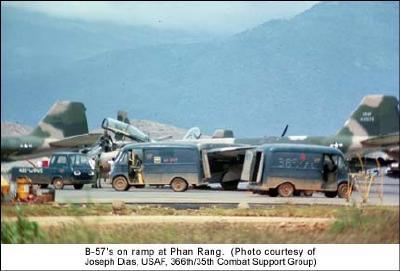
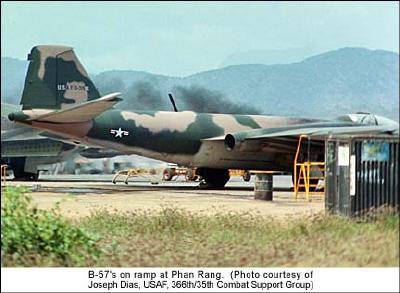 B-57s at Phan Rang (Mar 66) (Joseph Dias) B-57s at Phan Rang (Mar 66) (Joseph Dias)Friendly Fire Incident (Aug 66) During one of these strike missions on 11 Aug 66, a "friendly fire" incident
occurred. Point Welcome relates an "friendly fire" incident where a 8th TBS aircraft, Yellow bird 18,
made the first run on a US Coast Guard cutter, Point Welcome (WPB 82329).
After the intial run, an F-4 from the 35th TFW finished the job and sank the
cutter. This is also covered at USNI: Naval History with photos of the friendly-fire incident. "Friendly Fire, isn't" has become an old saw and one used to disguise a
multitude of human failings. Now called incidents, they were, and are, the
direct result of the growth of weapons technology and human inability or
willingness to control them. All martial conflicts are evolutionary processes
where coordination and cooperation evolve from the result of disaster. The
August 11, 1966, "Friendly Fire" expended on the United States Coast Guard
Cutter Point Welcome (WPB 82329) was one evolutionary link that forced a small
measure operational union during the Vietnam War.
About 0330, with sunrise just two hours away, the Point Welcome lay to in
Market Time Patrol Area 1A1 three-quarters of a mile south of the 17th
parallel.(2) The officer of the deck., Ltjg. Ross Bell, USCG, and helmsman, GM2
Mark D. McKenney, watched aircraft illuminate contacts outside the Cua
Tung(mouth of Ben Hai River). BM1 Billy R. Russell observed these same contacts
on radar above the 17th Parallel during the previous watch. The morning was
clear and although nothing appeared unusual Bell decided to start both Cummins
V12 engines and move farther south. Moving at a slow five knots, he resumed
patrolling 1A1's thirteen miles of coastline; however, within minutes aircraft
began illuminating the Point Welcome.(3) Bell sent McKenney to awaken Ltjg
David C. Brostrom, USCG, the commanding officer, but before Brostrom arose the
first firing run hit the cutter seriously wounding Bell. In later testimony
Bell said he saw no identification signals from the aircraft, "The next thing
we knew there was illumination directly overhead and a firing run was made."
Bell attempted to turn on the WPB's navigation lights and retrieve the Very's
Pistol but a second firing run "wiped out the bridge completely."
Yellow Bird 18, a B-57 from the 8th Bombardment Squadron made these attacks
following a Sky Spot mission where it dropped its bombs, presumably, on the Cua
Tung. Target. Traget designation came from Blind Bat 02, a C-130 from the U. S.
Air Force 21st Troop Carrier Squadron, from whom Yellow Bird 18 asked earlier
if it had any gun targets. Blind Bat reported negatively until alerted by Spud
13, an OV-1 Mohawk, with Side Looking Radar (SLAR) from the U. S. Army's 131st
Aviation Company. Spud 13, and its relief Spud 14, notified Blind Bat of a
large target that ran south at increased speed from the 17th Parallel. Both
Mohawks had "painted" three to five targets at the Cua Tung River and possibly
mistook the Point Welcome as one of the group. Spud 14 later testified that it was technically, but not practically possible,
that while making turns he could have lost the target and picked another.
However, interpretation of the "paint" either in the air or on the ground was
not a definite science and errors were common. After Spud 13 reported, Blind
Bat illuminated the WPB. At 0340 Yellow Bird 18 made the first "tail attack" at 0340 firing 800 rounds
of 20mm ammunition that "left him [the boat] burning." Following Yellow Bird's second attack the WPB's engines were opened to maximum
speed of eighteen knots that Blind Bat's pilot later estimated to be 30-35
knots.
Bell made one transmission to the Coastal Surveillance Center(CSC) at Da Nang,
"Article[call sign], this is Article India, I am under fire from Vietnamese
aircraft." CSC cooly replied, "Article India, this Article, roger, out." He
then pushed the engine controls to maximum speed. At 0350, in the adjacent
patrol area (1C) the Point Caution, offered help and received "This is India,
affirmative. I have taken hits and request assistance" but even at maximum
speed did not sight the Point Welcome until 0435... 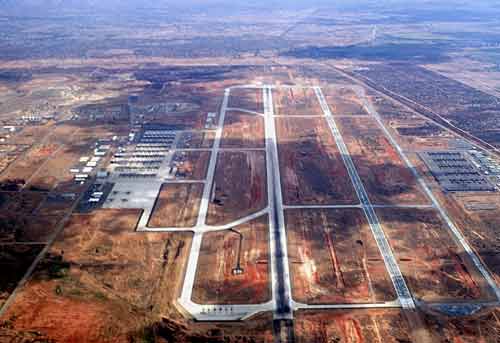
Phan Rang Looking North (1969) (71st SOS) 
Phan Rang Looking North (1969) (71st SOS) 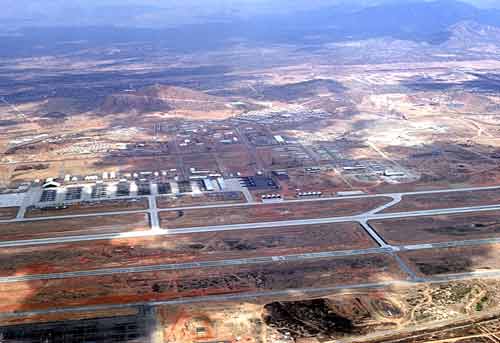
Phan Rang Looking West (1969) (71st SOS)
Move to Phan Rang (1966-1969) After the tragic start of their deployments at Bien Hoa (Aug 64-Nov 65), the
unit moved to Tan Son Nhut (May-Jun 65), then it moved to Danang (Jul 65-Oct
66).
In October 1966, 35th TFW wing transferred to Phan Rang Air Base, Republic of
Vietnam, to replace the 366th Wing. With the transfer, the 35th became the
parent wing at Phan Rang Air Base and began flying F-100 aircraft with
Detachment 1 of the 612th Tactical Fighter Squadron. The 8th and 13th Tactical
Bomb Squadrons followed the 35th to Phan Rang Air Base, while the wing gained
an attached organization: the Royal Australian Air Force Squadron No. 2 and its
MK-20 Canberra bombers.
Starting in October 1966, the 8th TBS and 13th TBS were attached to the 35th Tactical Fighter Wing of Phan Rang. From Oct 66 till the 8th left Phan Rang in Oct 69, it remained
in Phan Rang. In July 1969, the B-57s were phased out of the USAF inventory
and the remaining B-57s sent to the boneyard. The 8th was transferred without
equipment and personnel to the 3rd TFW in preparation for its transition to the
A-37B in Jul 69.
The 13th TBS was inactivated in Jul 69 and its assets sent to be modified into
B-52G aircraft. Eleven (11) were withdrawn early to support the B-57G program.
When the aircraft modifications were complete, the 13th TBS moved to Ubon
RTAFB, Thailand with the 8th TFW.
After the 13th departed from Clark, the 8th TBS was deployed to Phan Rang
permanently starting on 17 Jan 68. During this time, the B-57Bs were suffering
combat losses that could not be made up by drawing from ANG/Reserve assets. By
July 1969, the 8th TBS was down to 8 serviceable airframes. The decision to
retire the B-57 came in July 1969.
On October 15, 1969, a B-57B (s/n 52-1551), the last U.S. jet bomber based in
Vietnam, departed from Phan Rang as the United States sought to draw down its
forces stationed within the country before beginning the process of
disengagement from the war. Smithsonian NSAM stated that the National Air and Space Museum selected 52-1551 for its
collection because of that distinction. This aircraft had served with the 8th
Bomb Squadron for more than two years, flying both day and night bombing
missions.
Supposedly the B-57s used their bomb bays to carry more than bombs -- and were
used to bring in goods that couldn't be found in Vietnam. (NOTE: This was a
standard practice during the Vietnam War years as C-141s came home from Vietnam
stuffed with ceramic elephants in the crew bunk area; B-52s heading back to
Fairchild had all sorts of items strapped down in the 47-section near the
liferaft; KC-135s from Utapao headed home filled with teak furniture or rattan
papasan chairs.) The following photos and commentary are from Gene Bonham's website while he was stationed at Phan Rang in 1967 
(Gene Bonham)| This was taken from the top of the control tower, looking south east. Many of
the F-100s belonged to the 614th and 615th Tac Fighter squadrons. At the
extreme right were the B-57s of the 8th and 13th Bomber Squadrons.
(I think that you can see the Temple in the background). |
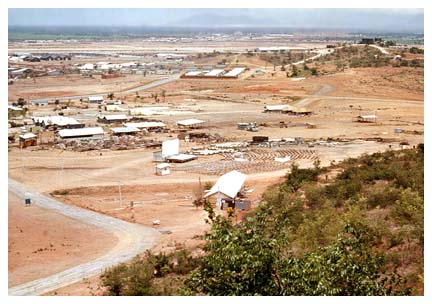
(Gene Bonham)| We spent many a night here at the drive-in. One of the odd things about
it was at times the old TV series "Combat" was playing. So you could
either watch "Combat" or the Gunships (AC-47s) make their nightly runs
around the main gate.....make believe or the real thing. While going to
the theater we also discovered that one could fit the better part of a case
of beer in all the pockets of a set of jungle fatigues. Youth, go figure. |
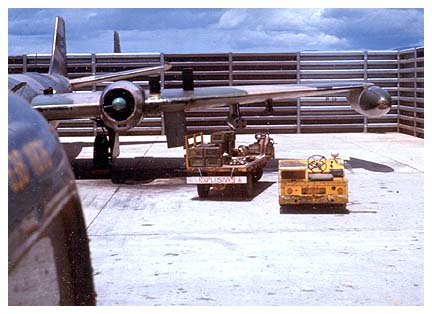
(Gene Bonham)| Getting ready to load the 20mm cannons on a B-57. The 20mm round has a High
explosive projectile, that's why the little trailer has a "Class A explosive"
sign on it. Every Fighter or Bomber that flew had a full load of 20mm rounds on
board, |


(Gene Bonham)| A couple shots of the "Nose Art " found on the B-57 bombers. There were not
many with art. I think it was up to the individual squadron Commanders. The
Bombers at PRAB were from the 8th or 13th Bomber Squadrons. They would rotate
every few months from Clark AB in the Philippines. When they rotated they would
come in with the bomb-bays loaded with all kinds of goodies (e.g., beer,
cigarettes, candy, Hondas motorcycles,...). Anything these guys could
peddle...and they did. At one time they set up a concession stand at the
theater. |
 | A Martin B-57B Canberra of the 8th Bomb Squadron an a mission over Vietnam In
December, 1967, heads for its target. The B-57 was one of the most effective
airplanes against ground targets because of its load carrying ability, loiter
time over the target, and ability to penetrate a given target due to its fast
pull-up capability. Higher performance lighter bombers lacked these qualities.
Dome atop rear fuselage is duplicate of one on lower fuselage. Both contain
TACAN antenna. (Air Power online: G2) |
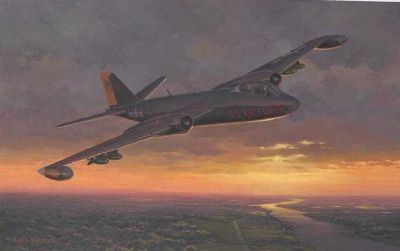 | Painting: Keith Woodstock: Vietnam 1967, and a B-57 sets out on a night
intruder mission against the Vietcong. This painting appears in the
commemorative book describing the history of the USAF, "From Sabre to Stealth".
(Keith Woodstock: Gallery) |
FAC Interface with B-57 on Night Interdiction in Laos (Nov 1967) The following is excerpted from Magic Gallery: B-57 on the Jimmie Butler Website dealing with the B-57B from the FAC (Forward Air Controller) perspective in
their Cessna O-2 Birddogs. In his references to the B-57s are for "Red Bird"
(13th TBS) and "Yellow Bird" (8th TBS). (See Jimmie Butler: Books for information on books written by Jimmie Butler on the Air War over Laos.) I never worked any B-57s during the day. I worked them as Red Birds or Yellow
Birds coming up from Phan Rang on the nights of 17 November and 23 November
1967. I liked adding a B-57, when available, to our night hunter-killer team,
which normally consisted of my O-2 and a T-28 from the Zorros of the 56th Air
Commando Wing at NKP. Sometimes as we searched a segment of the Trail, Alley
Cat (the night ABCCC controller) would offer us a B-57, and I'd always welcome
them. I guess we rendezvoused using our real TACAN coordinates (since the O-2
really did give the FACs a TACAN) and I suppose we must have turned on our
shielded upper beacon. Otherwise I don't know how the B-57 crew would keep
track of us, although once we flared, the site of the battle was obvious. While
we flew at about 4,200 feet (which was about 3,500 feet above the ground along
the main Route 911 in the lower ground between Mu Gia and Tchepone, the T-28
loitered above us at about 5,000. Seems like the B-57s said they were about
20,000, although that sounds high now that I think of it.
Anyway, all was quiet and pretty dark until my nav (usually Captain Bertram
Bilton) spotted trucks. We would flare and direct the T-28 against the trucks
while the B-57 stayed high above. You can see in the discussion below the more
colorful description (which I wrote in 1980) of what followed.
While we enjoyed the benefits of having a B-57 overhead in the Enforcer role,
the third aircraft increased the dangers of mid-air collisions where the strike
aircraft are flying blacked-out and we generally flew dark as well once the
rendezvous took place with out T-28. The Zorro pilot occasionally asked for a
flash of our beacon if he lost track of our black aircraft flying in the dark.
We used altitude separation as our main defense against mid-airs. Sometimes the
T-28 stayed below out altitude once the strike began, so our main concern
tactic was to tell the Zorro geographically where we were from the target when
he came down through our altitude and climbed back through after the strike.
When I cleared a Red Bird or Yellow Bird for attack from above, we and the
Zorro scrambled off to the side, and I usually dropped a few hundred more feet
when I was well away from the guns. The B-57 usually dropped a funny bomb (as
discussed below) into the mix without any of the three of us ever seeing each
other. A couple of years later—after FACs had been driven higher even at night
when the out-country war had shifted from North Vietnam and Laos to Laos—one of
Jim Roper's friends, Thomas Dutton, was lost in a mid-air collision near
Tchepone between his O-2 and a B-57.
* * * * * * * * * * * Night Strike Aircraft ComparedJust as FAC aircraft differed in their capabilities, there were marked
differences among the aircraft that attacked the trucks and guns at night in
Steel Tiger. One lesson was obvious. Jets that seldom cratered the road in
clear weather in the daytime could not really be expected to hit a truck moving
in the dark on the same road.
Colonel Aderholt, the Air Force's greatest proponent of propeller-driven
aircraft, told why he believed in the capabilities of the older aircraft.
The effectiveness of the A-26 and T-28 night recce/strike operations was due to
their ability to deliver their weapons with a higher degree of accuracy than
the jet fighter aircraft in SEA, coupled with their capability to remain on
station or in their assigned areas for relatively long periods of time and with
a useful payload. The effectiveness of the night attack operations of the B-57
showed that certain types of current jet aircraft” also can be effective
weapons systems. The T-28, A-26, and B-57 have a common characteristic, which contributes to
their accuracy of weapons delivery. These three aircraft have low wing
loadings, which permit them to deliver unguided ordnance at much shorter slant
ranges than aircraft with high wing loadings, which require higher altitude for
safe recovery from dive attacks. In essence, the majority of USAF fighter/bomber and attack aircraft operating
now in SEA have the same type of system for aiming and delivering ordnance, a
manually depressed sight for obtaining lead angles. The bombing results
obtained by the A-26, T-28, and B-57 verify that this aiming system is much
more compatible with these aircraft than with the F-105D and F-4C.
The T-28, A-26 and B-57 because of their limited speed are extremely vulnerable
when operated in areas heavily defended with AAA or in areas where they may
encounter enemy interceptor/fighter aircraft. These areas should be CAPed with
high-speed fighters or attacked with high-speed fighter bombers. [i]
Most Nail FACs agreed that the A-26s and T-28s were the easiest aircraft to
work with at night. The Nails also discovered that adding the B-57s (call signs: Redbird and
Yellowbird) as a third member of the hunter killer team was very comforting.
FACs assigned the “Enforcer” role to the B-57s, especially around FOXTROT, Ban
Laboy and other heavily defended interdiction points. As the FAC and the A-26
or T-28 patrolled the Trail, the B-57 orbited several thousand feet above. Once
the O-2 deployed a flare, the Yellowbird circled the shimmering light like a
hawk waiting to pounce on a field mouse. Then, if the gunners made the mistake
of really “hosing down” the A-26 or T-28, the Enforcer tried to pinpoint one
set of AAA and requested clearance for attack.
Anytime the FAC cleared a Redbird or Yellowbird in “hot,” a wild scramble
ensued in the black, night sky since none of the three pilots could see the
other aircraft. The FAC and the Zorro or Nimrod, determined to stay out of the
way of the B-57's attack, dived toward the jungle to the side of the target.
Although neither the FAC nor the gunners ever saw the B-57, its shadowy
presence was dramatically announced by the ignition of an M-35 or M-36 bomb. Nicknamed “funny bombs” because of their strange combination
of effects, the M-35 and M-36 incendiary bomb clusters combined the effects of
napalm, incendiaries, and CBUs. These bombs were the most awe-inspiring
ordnance the author witnessed in combat.
A small flash of fire in the air near the flare signaled the ignition of a
funny bomb. From the side, the aerial fire appeared as a fiery fist, opening
and growing as it descended toward the darkened jungle. The view from the
target must have been terrifying. The flames spread over an area larger than a
football field by the time the fire reached the ground. Then scores of thermate
bomblets exploded threatening anything in the area.
Normally, the Nail and its T-28 or A-26 resumed the strike without additional
problems.
In addition to the quality of the aircraft and the aircrew, the ordnance load
was a third key variable that determined the results of attacks at night. The B-57s' reign as a top truck killer was based, to a great degree, on the
destructiveness of the M-35 and M-36 bombs. Lieutenant Colonel E.S. Smith, the
8th Tactical Bombardment Squadron commander, stated that truck kills by B-57s
were four to five times higher when the M-36 funny bomb was available than when
other ordnance loads were substituted. The 900-pound M-36 had 182 thermate
bomblets that exploded on contact with the ground. A single bomblet could set a
truck on fire and destroy it. [ii]
The B-57s' accuracy, matched with the area coverage of the M-35 or M-36, made
the Redbirds and Yellowbirds the most effective jets on night attacks against
the Trail. The B-57s could have done more in Steel Tiger if they had been based
at NKP instead of at Phan Rang Air Base, South Vietnam. The flying times from
Phan Rang reduced the B-57's time in the Steel Tiger North to about one hour on
each mission. [iii]
[i] Colonel Harry C. Aderholt, "End of Tour Report," Nakhon Phanom Royal Thai
Air Force Base, Thailand: 56th Air Commando Wing, 19 November 1967, 7, 8.
(Hereafter cited as Aderholt Report.")
[ii] Lieutenant Colonel E. S. Smith, "End of Tour Report from 8TBS Commander,
LTC E. S. Smith," Phan Rang Air Base, South Vietnam. 8th Tactical Bombardment
Squadron, 13 June 1969, 5. Declassified M-S-42193-349 (Hereafter cited as Smith
Report.)
[iii] Igloo White Report, 3-24.
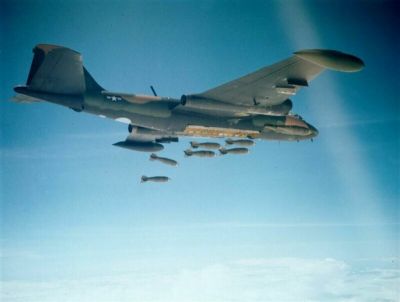 B-57 dropping bomb load B-57 dropping bomb load13th TBS Deactivated & 8th TBS attached to 35th TFW (Jan 68) On 15 Jan 1968, the 13th TBS was deactivated -- and its B-57Bs withdrawn from
service so that the unit could be "reborn" as a B-52G unit. Thus on 17 Jan
1968, the 8th TBS was attached to the 35th Tactical Fighter Wing at Phan Rang
AB. The 8th TBS would remain with the 35th TFW until combat losses could no
longer be filled from ANG/Reserve units. It was at this point, the USAF
decided to finally retire the B-57 -- a project it started in 1963.
In October 1969 when the B-57s were being phased out of the USAF active
inventory, the 8th narrowly escaped inactivation by 7th Air Force; saved only
because of the unique status as only one of two USAF units with a continuous
active history since WWI. They were reduced to a "paper unit" manning (1
officer & 1 enlisted) and the aircraft ferried to Arizona for storage. The
cadre of pilots for the new 8th and 90th Attack Squadrons entered training in
1969. The 8th was redesignated the 8th Attack Squadron in November 1969. In
1970, the 90th SOS and 604th Special Operations Squadron at Bien Hoa were
deactivated and the assets of the 604th absorbed into the 8th SOS.
TET Offensive (Jan 1968) On 15 Jan 1968, the 8th Tactical Bomb Squadron was assigned to the 35th
Tactical Fighter Wing at Phan Rang. For months, there had been a steady
buildup of North Vietnamese troops and artillery along the DMZ and tensions
were rising that something would happen.
General Vo Nguyen Giap led Vietnam's armies from their inception, in the 1940s,
up to the moment of their triumphant entrance into Saigon in 1975. In 1968,
Giap prepared a bold thrust on two fronts. According to Vets with a Mission: Tet Offensive, With memories of the victory at Dien Bien Phu still in his mind, he planned an
attack on the US Marines' firebase at Khe Sanh. At the same time the NVA and
the NLF planned coordinated attacks on virtually all South Vietnam's major
cities and provincial capitals. If the Americans opted to defend Khe Sanh, they
would find themselves stretched to the limit when battles erupted elsewhere
throughout the South. Forced to defend themselves everywhere at once, the
U~ARVN forces would suffer a multitude of small to major defeats which would
add up to an overall disaster Khe Sanh would distract the attention of the US
commanders while the NVA/VC was preparing for D-day in South Vietnam's cities
but, when this full offensive was at its height, it was unlikely that the
over-stretched American forces would be able to keep the base from being
overrun and Giap would have repeated his triumph of fourteen years before.
It's highly doubtful that the NVA/VC expected to hold all or even some of the
cities and towns they attacked, but the NLF apparently did expect large
sections of the urban populace to rise up in revolt With a few exceptions, this
didn't happen. South Vietnam's city dwellers were generally indifferent to both
the NLF and the Saigon Government but the VC clearly expected more support than
it actually got. The object of attacking the cities was not so much to win in a single blow as
it was to inflict a series of humiliating defeats on the Americans and to
destroy the authority of the Saigon Government. When the US/ARVN forces finally
drove the NVA/VC back into the jungle, there would be left behind a wasteland
of rubble, refugees, and simmering discontent. Stung by their defeats, the
Americans would lose heart for the war and what was left of the Saigon
Government would be forced to reach an agreement with the NLF and Hanoi which -
after a time - would simply take over in the South. This offensive would begin in January 1968 at the time of the Vietnamese Tet
(New Year) holidays. ...
By late January, some 6,000 Marines had been flown in to reinforce the Khe Sanh
garrison and thousands of reinforcements had been moved north of Hue. The NVA
build-up also continued; 20,000 North Vietnamese were ultimately moved in
around Khe Sanh but other estimates put the number at twice that Initially,
Giap would position his artillery in the DMZ and then send his assauIt troops
against the fortified hills surrounding Khe Sanh which the Marines had captured
in the dogged fighting in 1967. Having captured the hill positions, Giap
reasoned, the NVA artillery could be moved onto the heights above the
beleaguered base. Then - as happened at Dien Bien Phu - waves of determined
infantry would steadily grind away until the defenders were pushed into a
corner and finally over-run. The White House and the US media became convinced
that the decisive battle of the war had begun. TV news reports were so obsessed
with Giap's threatened replay of Dien Bien Phu that day-to-day life at Khe Sanh
became lead-story material even when it showed nothing other than anxious
Marines waiting for something to happen.
The first attack began shortly before dawn on January 21st, when the NVA
attempted to cross the river running past the base. It was beaten back but
followed by an artillery barrage which damaged the runway, blew up the main
ammunition stores, and damaged a few aircraft. Secondary attacks were launched against the Special Forces' defenses at Lang
Vel and against the Marines dug-in on the hills surrounding Khe Sanh but these
attacks were aimed more attesting the defenses than anything else. The next
day, helicopters and light cargo aircraft flew in virtually every few minutes
replacing lost ammunition but the weather began turning worse.
...
In the early morning hours of January 31st, the first day of the Vietnamese New
Year, NLF/NVA troops and commandos attacked virtually every major town and city
in South Vietnam as well as most of the important American bases and airfields. There were some earlier attacks around Pleiku, Quang Nam, and Darlac but these
were largely misinterpreted as the enemy's main thrust by those who were
expecting some activity during Tet Almost everywhere the attacks came as a
total surprise. Vast areas of Saigon and Hue suddenly found themselves
"liberated" and parades of gun-waving NVA/VC marched through the streets
proclaiming the revolution while their grimmer-minded comrades rounded up
prepared lists of collaborators and government sympathizers for show trials and
quick executions.
...
The After-Effects of Tet
The Tet Offensive and Khe Sanh may well have reminded Johnson and Westmoreland
of the Duke of Wellington's dictum:
"If there's anything more melancholy than a battle lost, it's a battle won"
Giap had been frustrated at Khe Sanh and defeated in South Vietnam's cities.
NVA/VC dead totaled some 45,000 anc the number of prisoners nearly 7000. But
the shockwave of the battle finished Johnson's willingness to carry on.
Westmoreland was pressuring Washington for 206,000 troops to carry on the
campaign in the South and to make a limited invasion of North Vietnam just
above the DMZ. As the battle for Hue died out, Johnson asked Clark Clifford
(who had recently replaced a disillusioned McNamara as Secretary of Defense) to
find ways and means of meeting Westmoreland's request.
Clifford and an advisor group looked at the war to date and among others,
consulted CIA Director Richard Helms who presented the Agency's gloomy
forecasts in great detail. On March 4th Clifford told Johnson that the war was far from won and that more
men would make little difference. Johnson then turned to his chief group of
informal advisors (which included among others, Generals Omar Bradley, Matthew
Ridgway, and Maxwell Taylor; Cyrus Vance, Dean Acheson, and Henry Cabot Lodge).
Johnson soon found that they too, like Clifford, had turned against the war.
According to Thomas Powers, Johnson's "wise old men" had been told that recent
CIA studies showed that the pacification programme was failing in forty of
South Vietnam's forty-four provinces and that the N LF's manpower was actually
twice the number that had been estimated previously. Not only had Tet shown
that the optimism of the previous year had been an illusion but it now seemed
that the enemy was far stronger than anybody had thought and that the long
efforts to win Vietnamese "hearts and minds" had largely been a disaster.
If Tet wasn't a full-scale shock to the American public, it was at the very
least, an awakening. The enemy that Johnson and the generals had described as
moribund had shown itself to be very alive and, as yet, unbeaten. America and
its ARVN ally had suffered over 4,300 killed in action, some 16,000 wounded and
over 1,000 missing in action. The fact that the enemy suffered far more and had
lost a major gamble mattered little because the war looked like a never ending
conflict without any definite, realistic objective. The scenes of desolation in
Saigon, Hue, and other cities looked to be war without purpose or end. Perhaps
the most quoted US officer of the time was the one who explained the
destruction of about one-third of the provincial capital of Ben Tre with
unintended black humor: "It became necessary to destroy it," he said, "in order
to save it". For many, this oft-quoted statement was not just a classic example
of Pentagon double-think but also a symbol of the war's futility. Westmoreland
became the parody "General Waste-mor-land" of the anti-war movement.
Being against the war became more-or-less politically respectable for liberal
elements. Robert Kennedy spoke of giving up the illusion of victory and
Democratic Senator Eugene McCarthy challenged Johnson for the Presidential
nomination on a peace platform. He was supported by thousands of students and
young Americans opposed to the war. Vocal elements of the extreme right largely supported the war but condemned
the Administration for not going all out for victory. The JCS backed
Westmoreland but convinced him to settle for half of the over 200,000
additional troops he wanted to take the initiative. The JCS then reported to
the White House that the extra men were needed to get things back to normal
following the battles of the Tet Offensive.
Johnson's dilemma was complete. He couldn't meet the generals' manpower
requests without either depleting Europe of American troops- which was
unacceptable- or without calling up the active reserves which would have been a
political disaster. His most senior advisors had turned against the war and Johnson took another
briefing from the CIA analyst whose gloomy reports had soured some of his most
hawkish counselors. A few days after this briefing, Johnson went on TV to
announce a bombing halt of the North and America's willingness to meet with the
North Vietnamese to seek a peace settlement. Johnson then said that he was not
a candidate for reelection under any circumstances and would spend the rest of
his term in a search for peace in Indochina.
One of those present at the special CIA briefing which convinced Johnson that a
change of course was inevitable was General Creighton Abrams, Westmoreland's
deputy commander. Shortly after Johnson's turnabout, Abrams replaced
Westmoreland as head of US forces in Vietnam.
Westmoreland came home to become Army Chief of Staff- a move many saw as a kick
upstairs- but, whatever the reasons behind the changeover, Abrams went to Saigon with a mission. He was to institute a program of'
Vietnamization" in other words, to take all necessary measures to enable the
ARVN to bear the main burden of the fighting and gradually return the chief
role of American troops to that of advisors. Vietnamization had always been a
feature of America's role in Vietnam but it had been on a back-burner since
1965 when it seemed that Saigon was incapable of doing the job. Now things were
to be returned to what they were supposed to have been from the beginning.
Vietnamization is usually credited to Nixon but it began in the wake of the Tet
Offensive and Johnson's turnabout.
Giap's gamble had another side effect When the Tet Offensive began, many US
officials believed that the NLF had offered the Americans a golden opportunity
by fighting a pitched battle where it could be defeated in open combat. In
effect, the NLF was "leading with its chin" and the massive losses it suffered
bear this out The VC was not broken by the Tet Offensive but it was severely
crippled by it and, from then on, the North took on the main burden of the war
Further fighting in 1968 and the increasing activity of the Phoenix Program
further decimated the NLF's ranks and the role of the North grew even larger.
The northern and southern parts of Vietnam had ancient cultural and social
differences and while the communist cadres at the center of the NLF had managed
largely to suppress these natural antagonisms, there still were basic
differences in goals and approach. The NLF had gone into the Tet Offensive in the hope of giving a death-blow to
the Saigon Government and, if it couldn't capture power directly, it could at
least gain a coalition leading to ultimate authority. The NLF's dream vanished
in the rubble of South Vietnam's cities and it would be Hanoi that conquered
Saigon.
Taken from the Vietnam Experience Ninteen Sixty-Eight For the detailed account of the Tet Offensive in Khe San, Hue, Saigon and
throughout the country go to Vets with a Mission: Tet Offensive "With Tet, Vietnam finally got America's attention. Millions of Americans
watched the battle for Saigon on the evening news, and many who were not
personally involved took notice for the first time. In the winter dusk of
American as 1968 proceeded, dreadful sights were broadcast. The cameras
recorded burnings, executions, even the sight of American soldiers falling in
battle. MACV was powerless to control news media that no longer trusted him. He
had sincerely believed there would be nothing to hide.
"Lyndon Johnson tried to explain it away and his own credibility suffered. On
February 27, the avuncular Walter Cronkite, a public surrogate, pondered the
question of whether "the bloody experience of Vietnam is to end in stalemate."
The decade that had opened in the winter sunshine of Kennedy's inaugural was
flickering out in a confusion of shadows and unwholesome light."
Mid-air Collision (Dec 1968) There was one well-publicized mid-air collision over Laos between a B-57B
from the 8th TBS and a C-123K on 13 Dec 1968 during a night mission. The 8th's
B-57Bs were staged out of Nakom Phanom RTAFB in Northern Thailand for the Laos
missions. On board the B-57 was Major Francis J. McGouldrick, Jr, copilot, and
Major Thomas W. Dugan, pilot, from Phan Rang, call sign "Yellowbird 72." On the
C-123K were Thomas Turner; Douglas Dailey; Morgan Donahue; Joseph Fanning;
Samuel Walker; Fred L. Clarke. All personnel were listed as missing in action.
The following is excerpted from Task Force Omega Inc.:The B57 Canberra was a light tactical bomber that played a varied role in the
Vietnam conflict. A veteran of operations Rolling Thunder and Steel Tiger,
B57's from the 8th Tactical Bombing Squadron at Phan Rang, South Vietnam had
also been equipped with infrared sensors for night strike operations in Tropic
Moon II and III in the spring of 1967.
On 13 December 1968, then Major Thomas W. Dugan, pilot; and Major Francis J.
McGouldrick, co-pilot; comprised the crew of a B57B Canberra, call sign
"Yellowbird 72." Their night bombing mission was being guided by a C123K
Provider, call sign "Candlestick 44," operating as the on site Forward Air
Controller (FAC) and whose mission it was to direct the bombers against a
convoy of enemy trucks traveling along Routes 911 and 912. These routes were
cut through the rugged jungle covered mountains approximately 2 miles north of
the demilitarized zone (DMZ), 14 miles northwest of Ban Namm, 18 miles
southwest of Ban Loboy, 35 miles northwest of Muang Xepon and 26 miles
southwest of the Lao/North Vietnamese border, Savannakhet Province, Laos.
Additional data places the loss approximately 47 kilometers northwest of Xepon,
3 kilometers east of Ban Kok Nak and Route 411, and 1 kilometer southeast of
Ban Pa Dong.
This area of eastern Laos was considered a major artery of the infamous Ho Chi
Minh Trail. When North Vietnam began to increase its military strength in South
Vietnam, NVA and Viet Cong troops again intruded on neutral Laos for sanctuary,
as the Viet Minh had done during the war with the French some years before.
This border road was used by the Communists to transport weapons, supplies and
troops from North Vietnam into South Vietnam, and was frequently no more than a
path cut through the jungle covered mountains. US forces used all assets
available to them to stop this flow of men and supplies from moving south into
the war zone.
Candlestick 44's crew was comprised of 1st Lt. Thomas M. Turner, pilot; 1st Lt.
Joseph P. Fanning, co-pilot; 1st Lt. John S. Albright, II, navigator; 1st Lt.
Morgan J. Donahue, navigator; SSgt. Douglas V. Dailey, flight engineer; TSgt.
Fred L. Clarke, loadmaster and SSgt. Samuel F. Walker, Jr., loadmaster.
Flying at an altitude of no more than 2000-3000 feet, the Provider crew's
mission was to spot enemy truck convoys traveling along the trail, then to drop
flares to illuminate the area for the accompanying bombers to attack. Weather
conditions at the time were clear with a half moon, ground fog, no wind and no
cloud ceiling. At 0300 hours, as the crew of the C123K guided the B57B onto an
enemy convoy, the FAC was jolted by a blow to the top of their aircraft in the
aft section by the overhead bomber as it approached the target. Candlestick
44's pilot, 1st Lt. Turner was stunned by a blow to the head and lost
consciousness as his aircraft lost power. Because of its glider configuration,
the C123K did not fall straight to the ground, but drifted lazily in a slow
flat spin that lasted several minutes.
During his post-rescue debriefing, Thomas Turner reported: "Yellowbird 72 made either one or two passes over the target and received no
ground fire while Candlestick 44 maintained position in our quadrant at
altitude. While the bomber conducted its strikes, I began a run to our left in
order to stay in our own quadrant, yet be able to scope to clear the previous
strike (to observe the bomber's attack pass and its pull off of the target).
Just as we rolled out straight and level, I looked out the window and saw the
strike area. The next moment there was an explosion and the aircraft was out of
control. I was knocked unconscious for several moments. When I came to, I turned in my seat and could see the co-pilot's seat was
empty and fire was coming into the cockpit from the fuselage area. I turned to
the left and opened the window, then unbuckled my seatbelt. I looked out at the
wing tip and could see the wing tip and that the left engine was still running.
The next minute I was out and clear of the aircraft. I pulled the "D" ring when
clear to deploy my parachute. On my descent I saw another parachute below me
and 2 or 3 fires on the ground. At that time I was unaware of the other
aircraft's fall, and didn't know if it was one of the fires on the ground or
not." 1st Lt. Turner went on to say: "I landed safely in a treetop where I
remained until search and rescue (SAR) personnel rescued me at dawn. I did not
hear any of the other crewmen come up on the radio, and I understand that the
only beeper the SAR aircraft heard was mine."
Members of other aircrews provided additional information about this loss
incident. One witness stated he saw a steady stream of enemy anti-aircraft
artillery fire aimed in the direction of the aircraft just before the large
explosion caused by the collision. Several other witnesses reported there was a
large explosion that broke the aircraft into three parts shortly after the
initial explosion.
After plucking Thomas Turner out of the tree, aerial SAR personnel continued to
search for the other crewmen in the rugged jungle covered mountains. Because
this area was under total enemy control, no ground search was possible. At 0900 hours on 15 December, the formal SAR effort was terminated when no
trace of the remaining crew could be found. At that time Thomas Dugan and
Francis McGouldrick were listed Missing in Action. Likewise, no trace of the
C123K crew was found and they were also declared Missing in Action at the same
time.
Over the years numerous reports filtered through the intelligence community
regarding the crews of the Canberra and the Provider including National
Security Agency (NSA) intercepted enemy radio communications correlated to at
least 3 of the missing men. In 1974 a Laotian refugee who escaped reported
having observed an American prisoner thought to have been a member of this
aircrew who had been moved to the caves near Tchepone where he was held during
the 1968 to 1970 timeframe. This American was later transferred to another
location unknown to the refugee.
Thomas Dugan and Francis McGouldrick are among the nearly 600 Americans who
disappeared in Laos. Like this aircrew, many of these men were known to be
alive on the ground. The Laotians admitted holding "tens of tens" of American
Prisoners of War, but these men were never negotiated for either by direct
negotiations between our countries or through the Paris Peace Accords that
ended the Vietnam War since the Laotians were not a party to that agreement. The primary role of the B-57 was close air support or night interdiction. At
times it was called upon by FACs for strike sorties against targets, but not
many. For example, an F-4 might be called upon 150 times and an F-100 a 100
times, but the B-57 would be only called upon three times. (See Project CHECO Report: Interdiction at Ban Bak: 19 Dec 70 to 5 Jan 71 29 --
January 1971.)
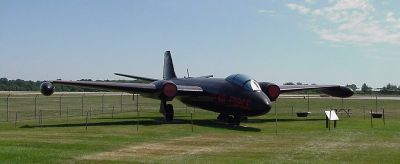
B-57 static display in 8th TBS markings. (Air zoo)
Doom Pussy Aircrews who flew early missions into North Vietnam wore the DOOM PUSSY
(Danang Officers' Open Mess) patch. The DOOM PUSSY was turned to the wall each
night until the crews returned. The words in Vietnamese mean, "I have flown
into the jaws of the Cat of Death". Later all crews who participated in the
night missions wore the insignia. 
Doom Pussy
(Courtesy Marquis Witt www.b-57canberra.org)
I HAVE FLOWN INTO THE JAWS OF THE CAT OF DEATH Bob GalbreathI designed the original patch [left]. The original plan was for the patch to
say "Into the Mouth of the Cat of Doom" in English. Then one night at the bar
in the compound at Bien Hoa between rounds of "Diesel and Juice" a group of us
including Smash Chandler, Art Jepson and some others started talking about
maybe the motto should be in Latin because it would be more "classy"**. Then
someone - my recollection is that it was Art [Jeppson]. but perhaps it was
someone else -- had the idea that it should be in Vietnamese. So some time
passed while I was looking for someone to translate the words when the ramp
explosion at Bien Hoa took place on 16 May 65. (I was the nav in the last plane
to taxi off the ramp and was sitting at run-up when the explosion started.)
Art was killed in the explosion and that prompted me to move ahead with the
patch because he had been so enthusiastic about it. We were living in the Dust
Off barracks at Tan Son Nhut after evacuating from Bien Hoa and, in
desperation, I ended up asking one of the laundry girls thereto translate the
words. She translated it as "Trong Mieng Cua Con Men Cua Tham Phan." I took the
design to the tailor shop in Saigon called Cheap Charlie's and ordered about
fifty patches.
Months later, in November or perhaps December, after we had permanently moved
to Danang, some crews were on the way to the flight line one day in the bread
truck [ a van-type vehicle used for crew transport] and we were discussing the
need for a new order of patches. A VNAF [Vietnamese Air Force] pilot, Capt Lan,
whom I had flown with during his B57 training at Clark, was with us and he told
us that he didn't think the patch said what we thought it said. That evening at
the club (the DOOM club of course) I discussed it with Lan. He said that he
felt that "tham phan" really meant "destiny" and that doom would probably be
"dinh mang”. Although he said that the concepts of Doom and Destiny were
complex in Vietnamese culture and that it was open to interpretation.
I remember thinking at the time that "destiny" was not really what we had in
mind when we conceived the emblem so the next order for patches which went out
a few days later, included "dinh mang" in place of "than phan" and the rest is
history as they say. It would be interesting to have the motto professionally
translated and find out who was right; the captain or the laundry girl.
My only quibble with the translation you have on the web site, "I have flown
into the jaws of the Cat of Death and returned", is with the words "and
returned;" While it is true that a guy who didn't return wouldn't have a need
for a patch, it was really him and the possibility,' of ourselves being him
that was on our minds when we conceived the patch. I guess philosophically the
point is, going up there was enough; you didn't have to return to earn the
patch.
Incidentally, as you probably know, the patch was copied over and over for the
rest of the war by lots of people who had no connection with the original North
Vietnam at night mission or any idea what “Canberra Night Fighter” was.
Somewhere along the line a strip saying, “The Doom Pussy”, was added to the
bottom of the patch. This was never a part of the original design.
**Speaking of “classy”, the first draft of the design showed a Canberra
disappearing into the darkness of a saber-toothed, human vagina! However, we
decided that as lax as uniform standards were at the time, the colonels
probably wouldn’t let us wear a patch like that. So the “pussy” was changed to
a cat.
Bob Galbreath
Editor’s note: I do know of some civilian females who were unfortunately given
the patch as “souvenirs”. No doubt there was others who received it
undeservedly. As for the rest of us who DO know the Canberra story and flew its
night missions in “another country” against triple A fire and in memory of
those comrades who did not return, there is a special feeling towards the
emblem - whatever its interpretation. I have changed the motto where it appears
on this web site and thank Bob for his correction. -- M.W.
B-57 Maintenance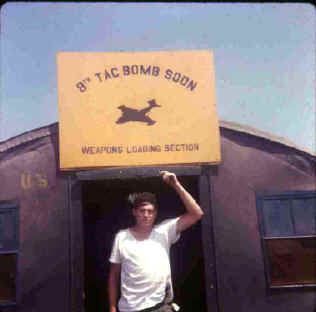
8th TBS Weapons Loaders
(Courtesy Marquis Witt www.b-57canberra.org)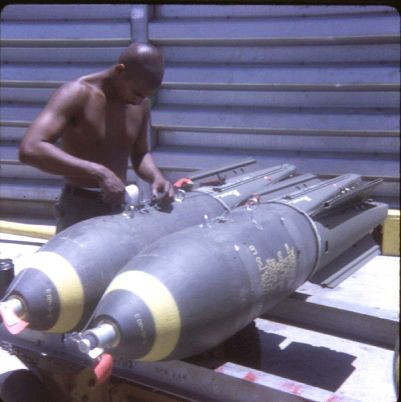
8th TBS Weapons Load Crew Chief John Vasquez
(Courtesy Marquis Witt www.b-57canberra.org) The Bomb-handlers: According to Lt Col E.S. Smith's "end of tour report," "In addition to the
quality of the aircraft and the aircrew, the ordnance load was a third key
variable that determined the results of attacks at night. The B-57s' reign as a
top truck killer was based, to a great degree, on the destructiveness of the
M-35 and M-36 bombs. Lieutenant Colonel E.S. Smith, the 8th Tactical
Bombardment Squadron commander, stated that truck kills by B-57s were four to
five times higher when the M-36 funny bomb was available than when other
ordnance loads were substituted. The 900-pound M-36 had 182 thermate bomblets
that exploded on contact with the ground. A single bomblet could set a truck on
fire and destroy it." (Source: Lieutenant Colonel E. S. Smith, "End of Tour
Report from 8TBS Commander, LTC E. S. Smith," Phan Rang Air Base, South
Vietnam. 8th Tactical Bombardment Squadron, 13 June 1969, 5. Declassified
M-S-42193-349).
The following is from Dan English on the Canberra.org: War Stories, "One of the more exciting parts of our job were the occasions when we would
be assigned to the arm/de-arm area. There, we would remove all the arming
devices and charge the rounds into the guns so they would be hot. This would
all happen at the end of the runway prior to take-off; the noise was deafening
especially when the B-57 engines were being revved up This was particularly
exciting on the 50 caliber planes, because we would have to climb up onto the
wings of the B-57 with its engines running, remove the tsus fasteners, put a 50
caliber round over the pawl and then button it back up again. Often, the
fasteners wouldn't cooperate, and there were some anxious moments in making
sure the gun doors were properly buttoned up. On the 20 mil. aircraft, we would
charge the round into the gun from a gun door under the wing. Occasionally, we
would have trouble getting a round charged in. When the aircraft returned, we
would reinstall arming devices, as needed, and remove any rounds that were
chambered in the gun. During every tour of duty, you would hear horror stories
of a round being pickled off in the revetment area due to a hot gun. I don't
know how much truth there was to these stories. Dan English - Phan Rang 1968"
The following is the Weapon Loader's perspective by Dan English on the B-57
from Canberra Org: Armament
"As far as the letter designations, I'm not sure who introduced the concept.
The A-man was the crew chief, and his job was to oversee the whole bomb and gun
loading procedure. He racked the bombs and helped with any final arming wire
installation and bomb loading post checks. The B-man's first job was in the
pre-check of the aircraft weapon system. He would climb up into the cockpit and
pickle off all the bomb racks while the rest of the crew checked to make sure
the racks would release. On a rare occasion, we would have to swap out a rack
prior to loading. The B-man would also help in loading the first bomb, but
after that he was usually involved in installing the arming wires after the
bombs were loaded. The C-man was the MJ-1 driver, and his job was to get the
bomb into position so the crew chief could rack it in from the loading table.
The C-man would also help in the loading of the guns. The D-man's job usually
positioned him at the tail fin, and his job was to help guide the bomb into
position. All bomb crew members would help in the loading of the guns, final
arming wire installation and revetment clean-up after the load, making sure
that all pieces of arming wire and scraps from the loading process were picked
up. Bomb loading crews who had been together for a while as ours was, became
extremely efficient at loading an aircraft in a short period of time."
Canberra Commemorative Cover (1998) 
B-57 Canberra Commemorative Cover (1998)The English Electric Canberra is one of only two U.S. combat aircraft that have
been designed outside the United States since the end of World War II. First
flown in 1949, this unique aircraft could reach altitudes of 60,000 feet. The
U.S. Air Force inherited the design from the Royal Air Force in the form of the
RB-57F. The improved U.S. version cruised easily at 100,000-foot altitudes --
making it ideal for reconnaissance missions. With a wide-reaching range of
4,000 miles, this versatile aircraft also saw use as a light bomber. After the
establishment of the Strategic Air Command (SAC), the Canberra became an
important part of America's nuclear bomber fleet. In 1965, the Canberra
conducted the first major U.S. Air Force attack on the Viet Cong in South
Vietnam. The B-57 Canberra Art Print and Commemorative Cover feature artwork by
Jack Fellows. The Commemorative Cover displays the 1996 32¢ Department of the
Air Force Mint Stamp.
Original painting for the Fleetwood® Commemorative Cover and Art Print by Jack
Fellows. Actual size of cover: 7-1/2 x 3-7/8 inches. Actual size of print: 8 x
10 inches. Reverse contains historical background text.
Design and text ©1998 Fleetwood®. A Unicover® Edition. All rights reserved.
Standard Number: None Stock Number (SKU): 571064 US$ Price: $10.50
(SITE NOTE: The B-57 Canberra bears the "PQ" tail code of the 8th Tactical Bomb
Squadron of Phan Rang.)
The following is from Historical Text Archive: Don Mabry: Nixon widened the war, however. He defined victory as the preservation of a
non-Communist government in Saigon. To achieve victory, he adopted measures
long advocated by the military but rejected by Johnson. In March, 1970, Prince Sihanouk of Cambodia was overthrown, probably by the
CIA and the right-wing General Lon Nol took his place. North Vietnamese troops
poured into interior Cambodia. On April 30, 1970 Nixon ordered the invasion of
Cambodia. Although the US had been secretly fighting there, this invasion was a
widening of the war. The Cambodian invasion sparked serious protests. The
anti-war movement had been quiet for most of 1969, giving the new president a
honeymoon as he began implementing his "secret plan." In October, 1969, the
Vietnam Moratorium Committee brought 500,000 to Washington, DC to protest the
war and encourage Nixon to end it. The Nixon administration condemned the
protest meeting. It indicated that anti-war sentiment had grown substantially.
Nixon became even more anxious to win the war. When Cambodia was invaded in
April and May, 1970 one and one-half million students protested on 1200
campuses. On May 4th, four students, on their way to class, were murdered by
National Guard troops who had been called into action by the governor because
of the anti-war demonstrations on the Kent State campus. On May 14th, two
Jackson State students were murdered by Mississippi Highway Patrol officers who
fired on a dormitory when students there protested the war and racism. Many
Americans were outraged while many others believed that the students had asked
for it. These incidents were further evidence of how the war was tearing the
nation apart. Congress began raising questions about the constitutionality of
the invasion and repealed the Gulf of Tonkin Resolution, one of the few legal
props for the war.
The Cambodian invasion failed to cut off North Vietnamese and Viet Cong
progress and Congress refused to fund Nixon's planned invasion of Laos. In
February, 1971, Nixon used US air power to support a South Vietnamese invasion
of Laos. This, too, failed.
As US troops were being withdrawn, Nixon stepped up the use of US air and naval
power. From 1969 to the end of 1971, the US had dropped 3.3 million tons of bombs on
South Vietnam, North Vietnam, Cambodia, and Laos, more than Johnson had dropped
in five years and more than the US had dropped on Europe and the Pacific in
World War II. Nixon was trying to bomb the enemy into submission but it did not
work. In the Spring of 1972, North Vietnamese forces launched an offensive which
pushed back South Vietnamese forces. Nixon widened the bombing of North Vietnam
and mined its harbors but the war was lost. The Nixon administration had been
engaging in secret negotiations between 1969 and 1971 as Henry Kissinger made
thirteen trips to France to meet with North Vietnamese diplomats. The US
proposed a cease fire in advance of any political settlement and the
preservation of the Thieu regime. Nixon had asserted that Thieu was one of the
four or five greatest political leaders of the world, and supported Thieu in
the 1971 presidential election, one so fraudulent that all of his opponents
withdrew. But in 1972, shortly before the US presidential election, Nixon
announced progress towards a cease fire. The war ended in 1973. Nixon resigned
in 1974 so he did not preside over the rout of the South Vietnamese in 1975
when the North Vietnamese armies took over the entire country.
The war was costly. One and one-half million died in Indochina of whom 58,000
were Americans. Millions more were maimed. Some 500,000 people became refugees.
From 1965-1971, the US spent $120 billion dollars directly on the war but other
costs raised this amount to $400 billion. Costly, too, was its effect on the US
military which thought itself invincible and had difficulty accepting the fact
that it was not. Of course, the War of 1812 was a draw, at best, but Americans only paid
attention to recent events. It was a long war but not as long as the War on
Drugs or the perpetual war that the War on Terrorism promises to be. It left
open wounds on the US psyche. (See Base Development in South Vietnam 1965-1970: Chap 10: Base Camps for Base Camps information.)
For inputs or comments, contact Kalani O'Sullivan.NOTICE/DISCLAIMER: The content of this page is unofficial and the views and
opinions expressed do not necessarily reflect those of anyone associated with
this page or any of those linked from this site. All opinions are those of the
writer and are intended for entertainment purposes only. Links to other web
pages are provided for convenience and do not, in any way, constitute an
endorsement of the linked pages or any commercial or private issues or products
presented there.
 You are listening to CCR: Bad Moon Rising You are listening to CCR: Bad Moon Rising
Return to Top | 
28 October 2003 |
For inputs or comments, contact Kalani O'Sullivan.NOTICE/DISCLAIMER: The content of this page is unofficial and the views and
opinions expressed do not necessarily reflect those of anyone associated with
this page or any of those linked from this site. All opinions are those of the
writer and are intended for entertainment purposes only. Links to other web
pages are provided for convenience and do not, in any way, constitute an
endorsement of the linked pages or any commercial or private issues or products
presented there.
Copyright 2003 - All Rights Reserved
email to: kalani@hanvit.com

FastCounter by bCentral
|

